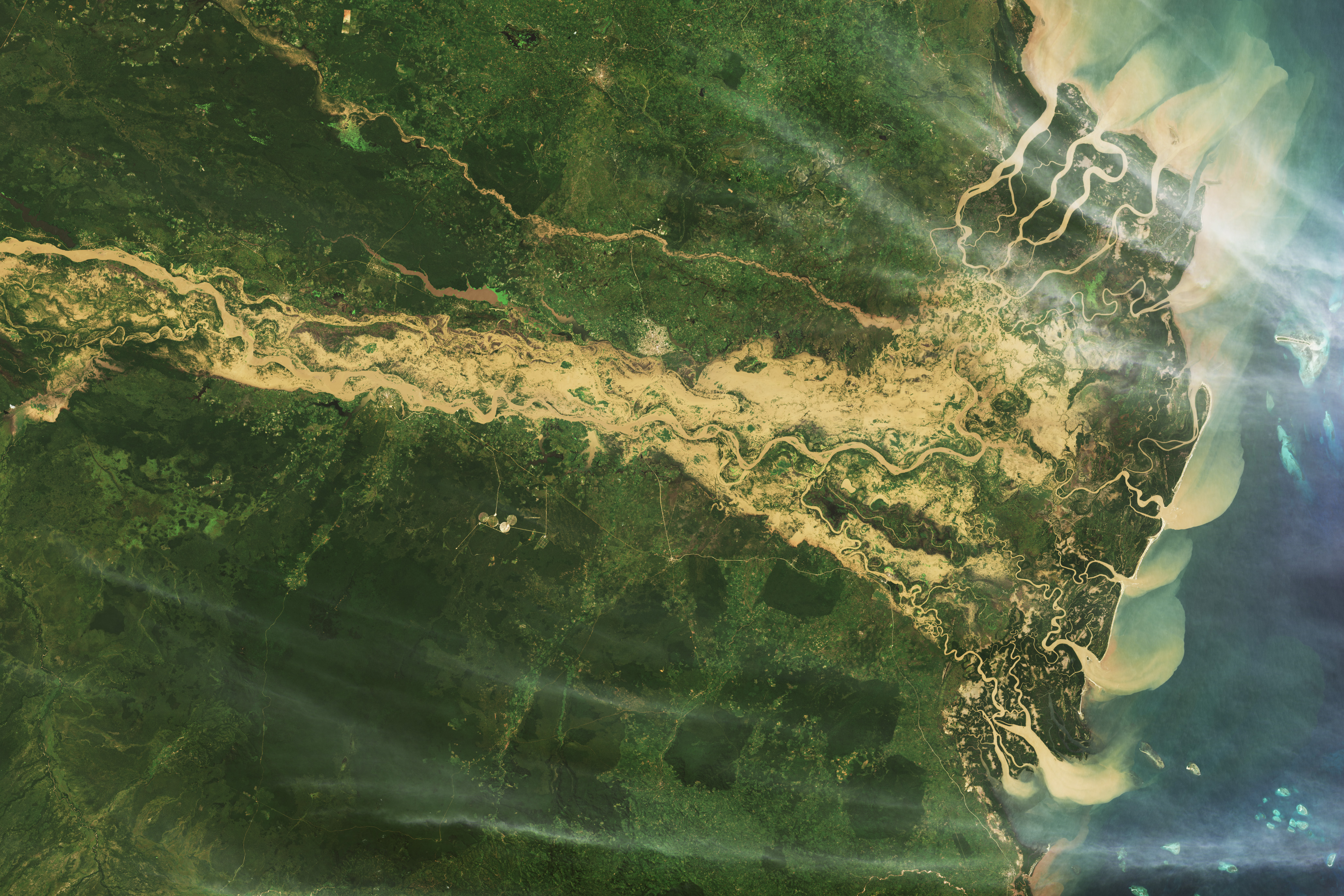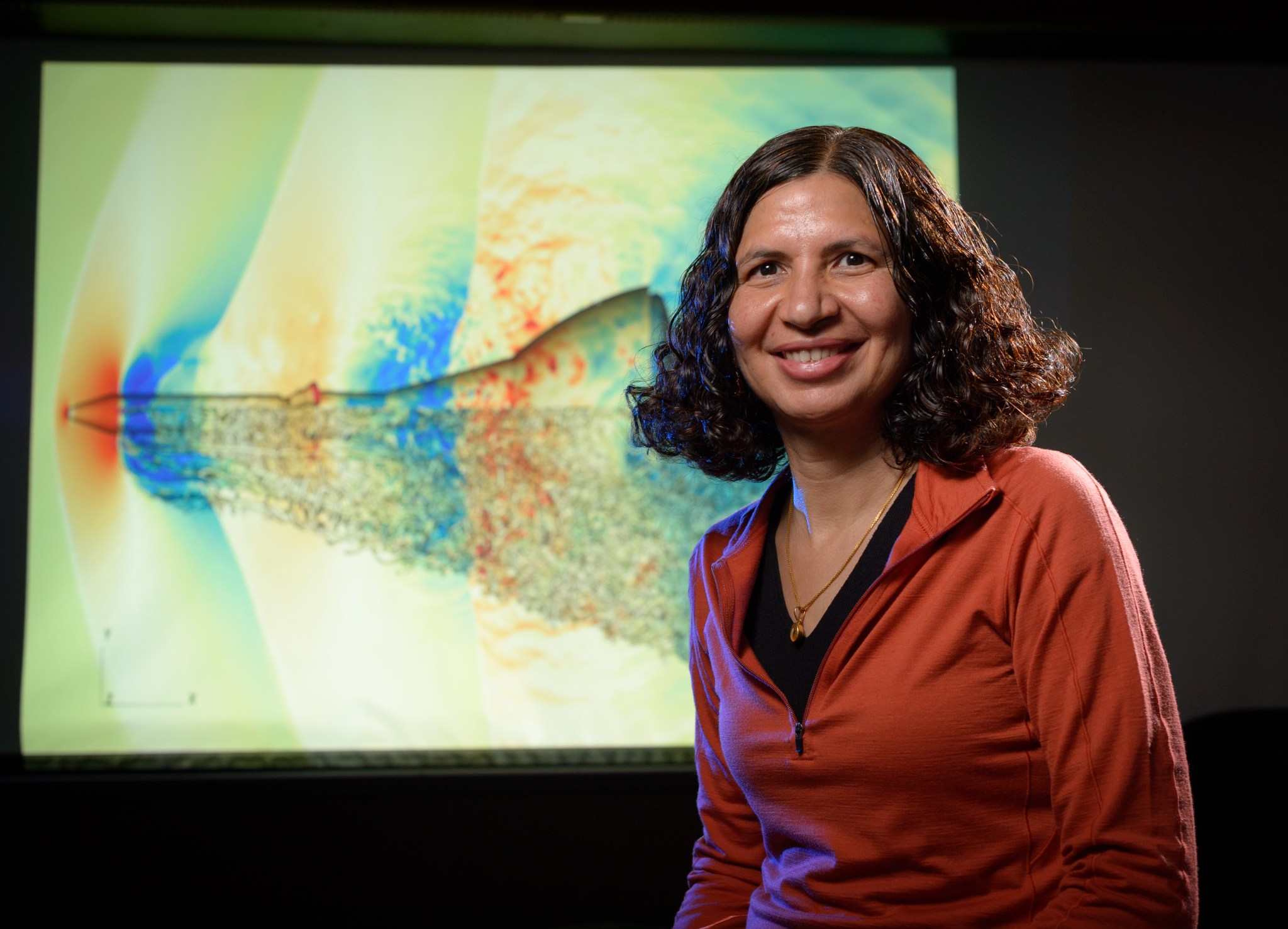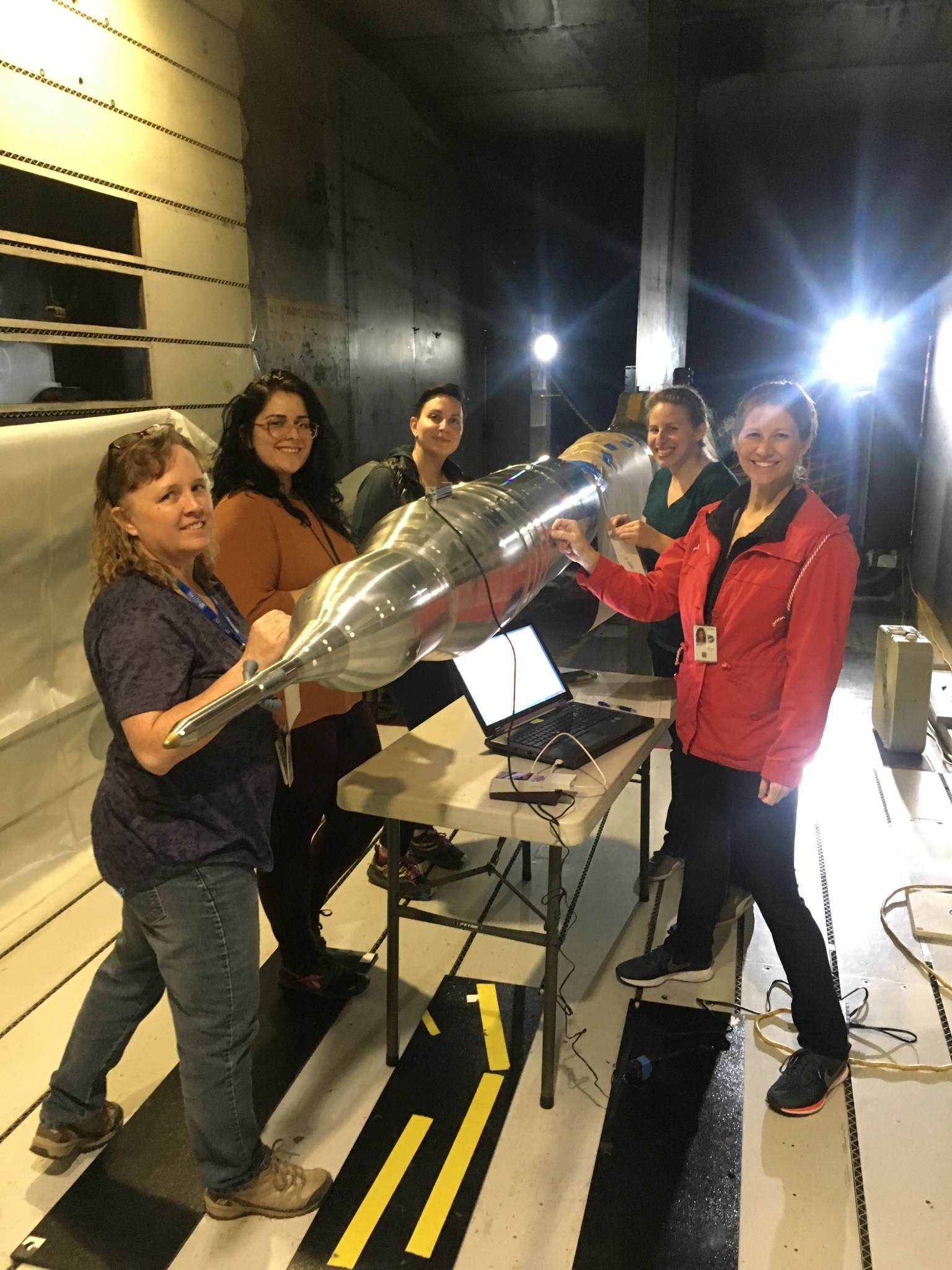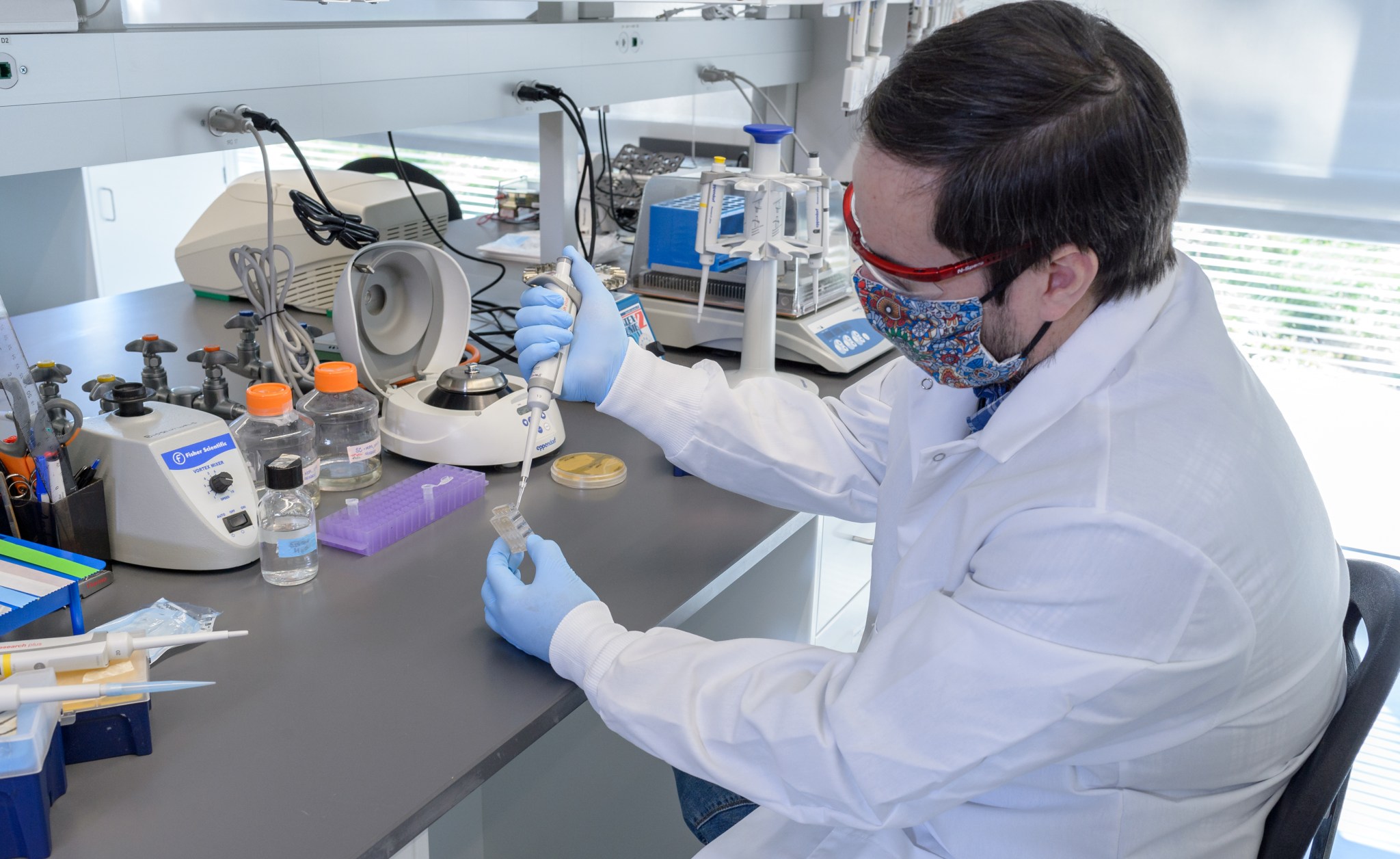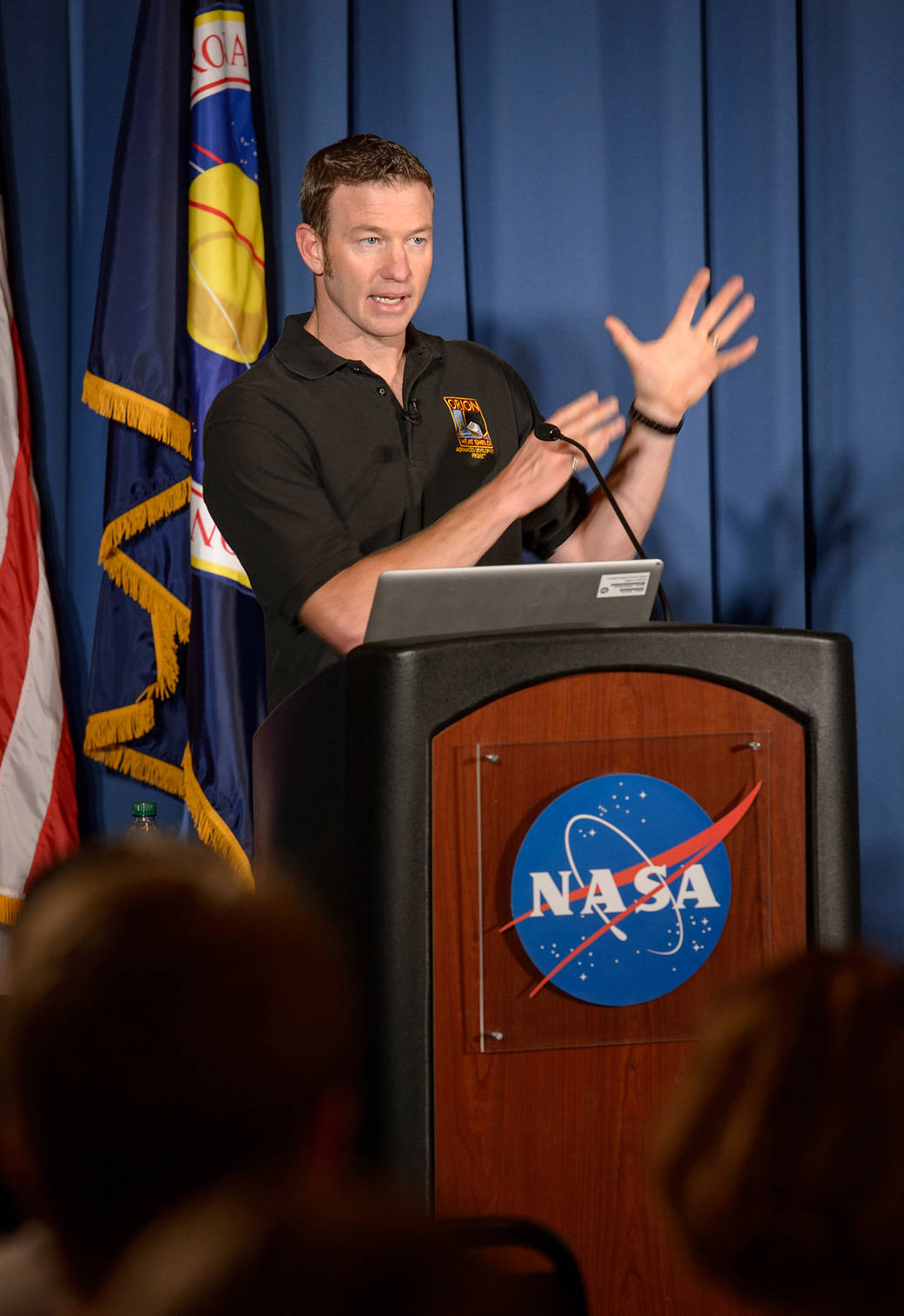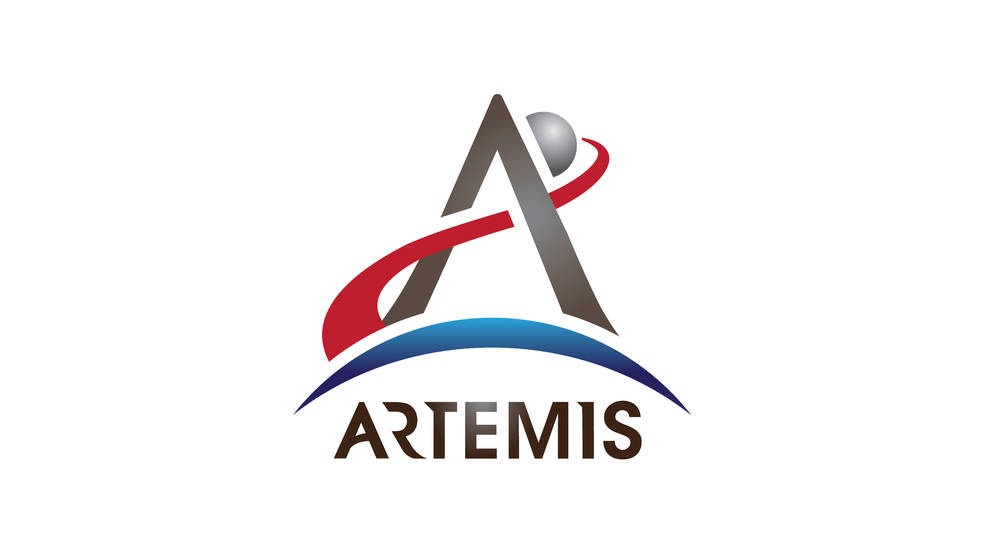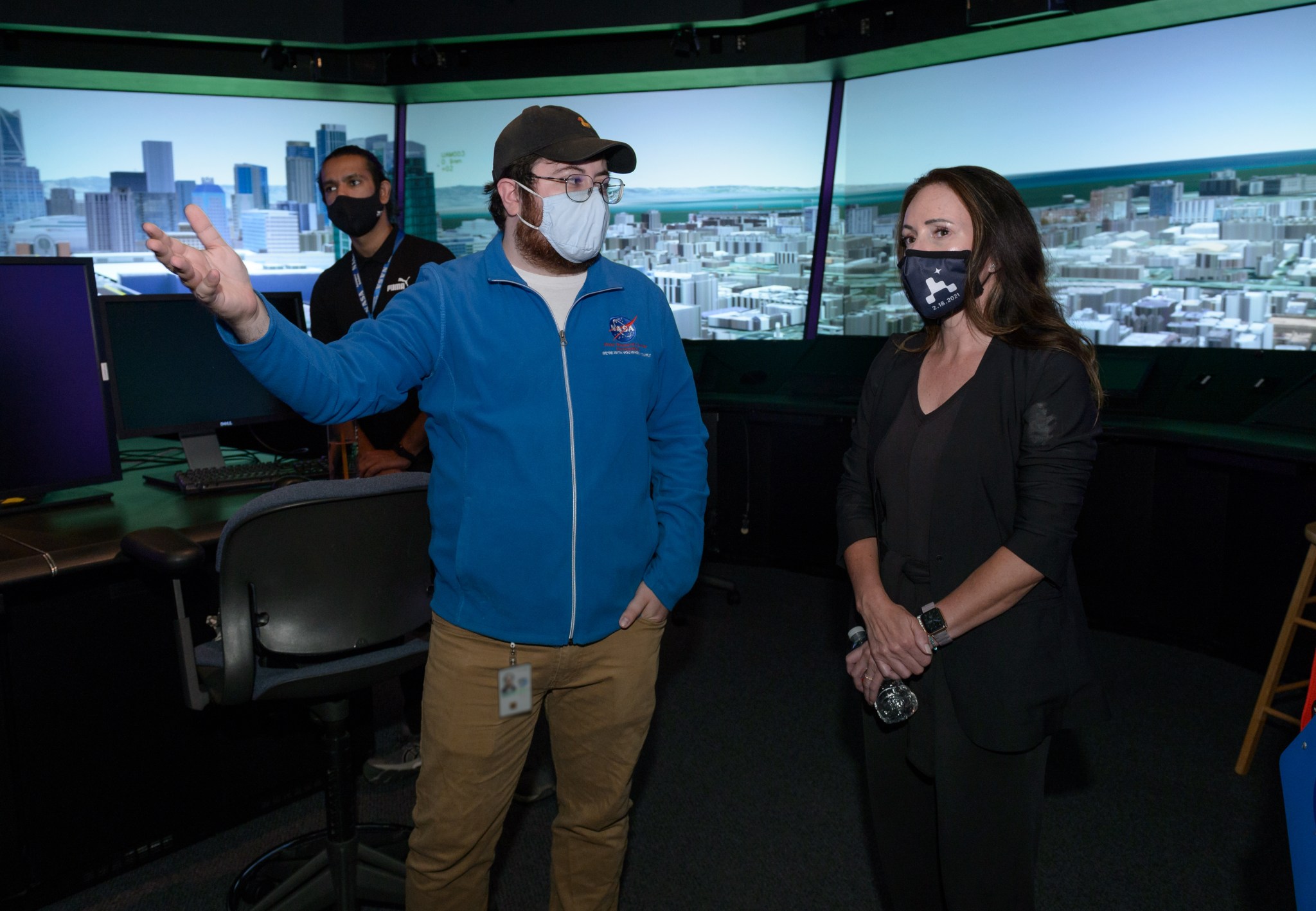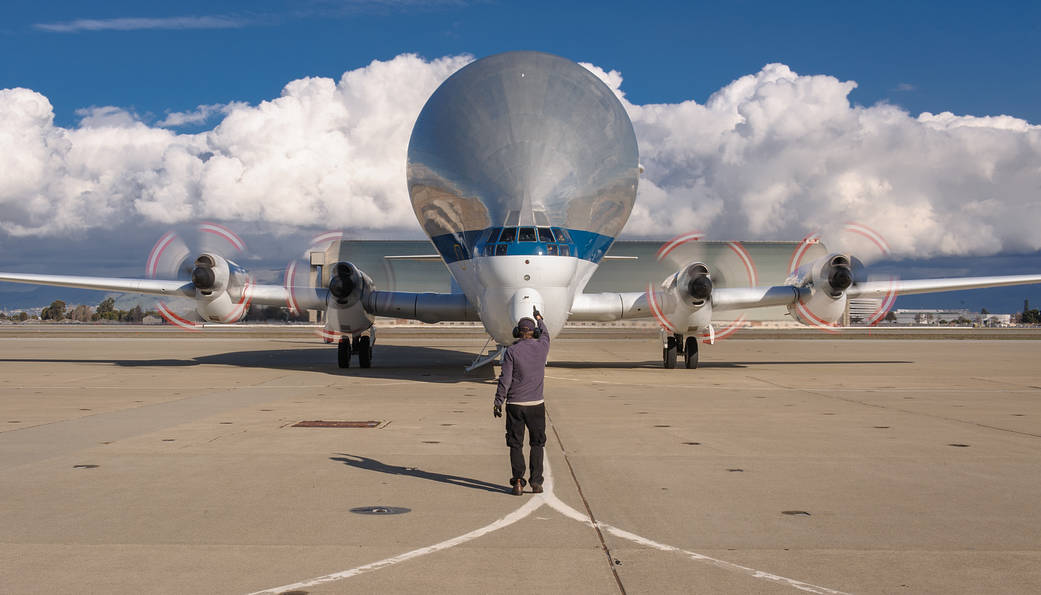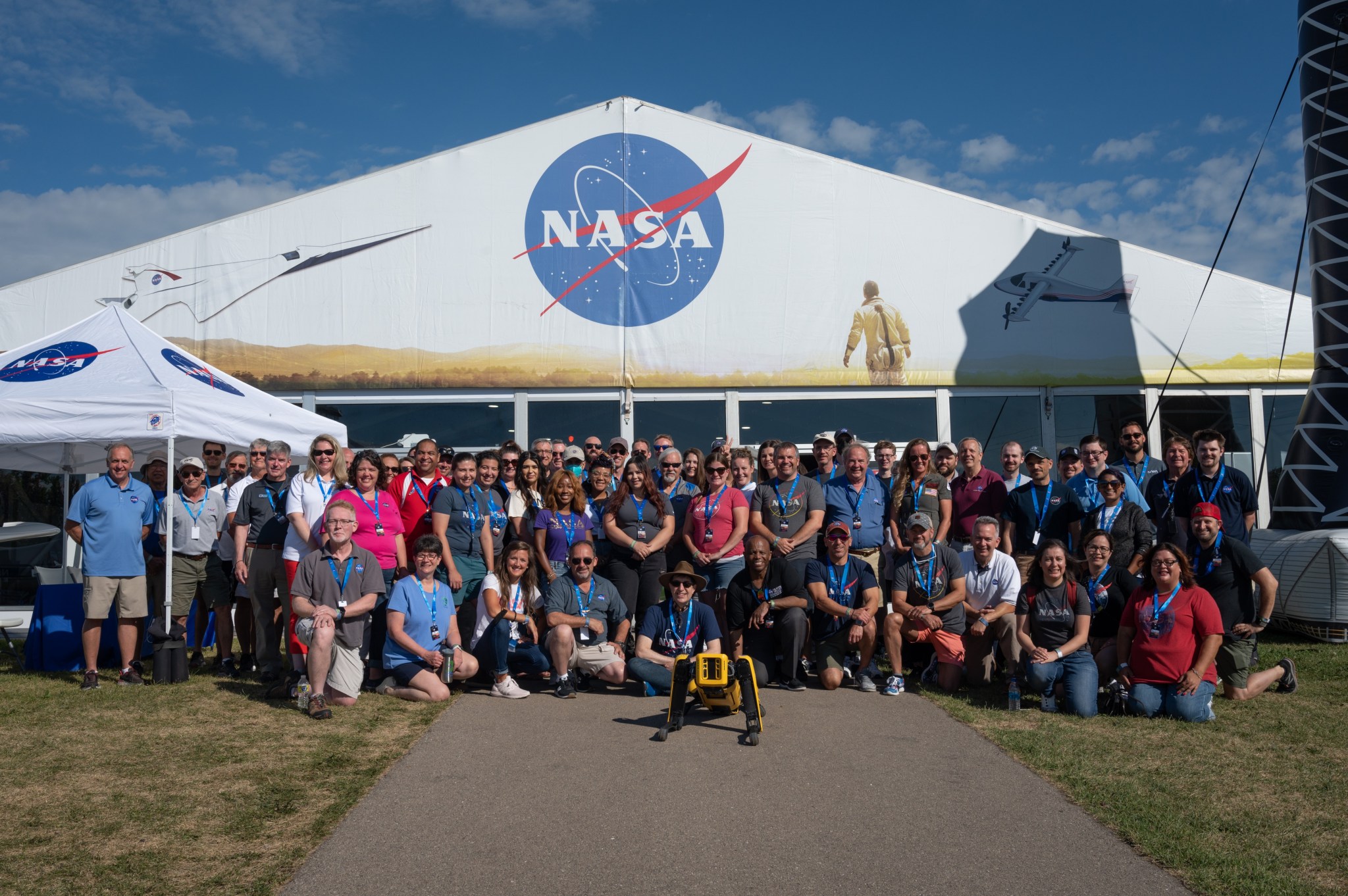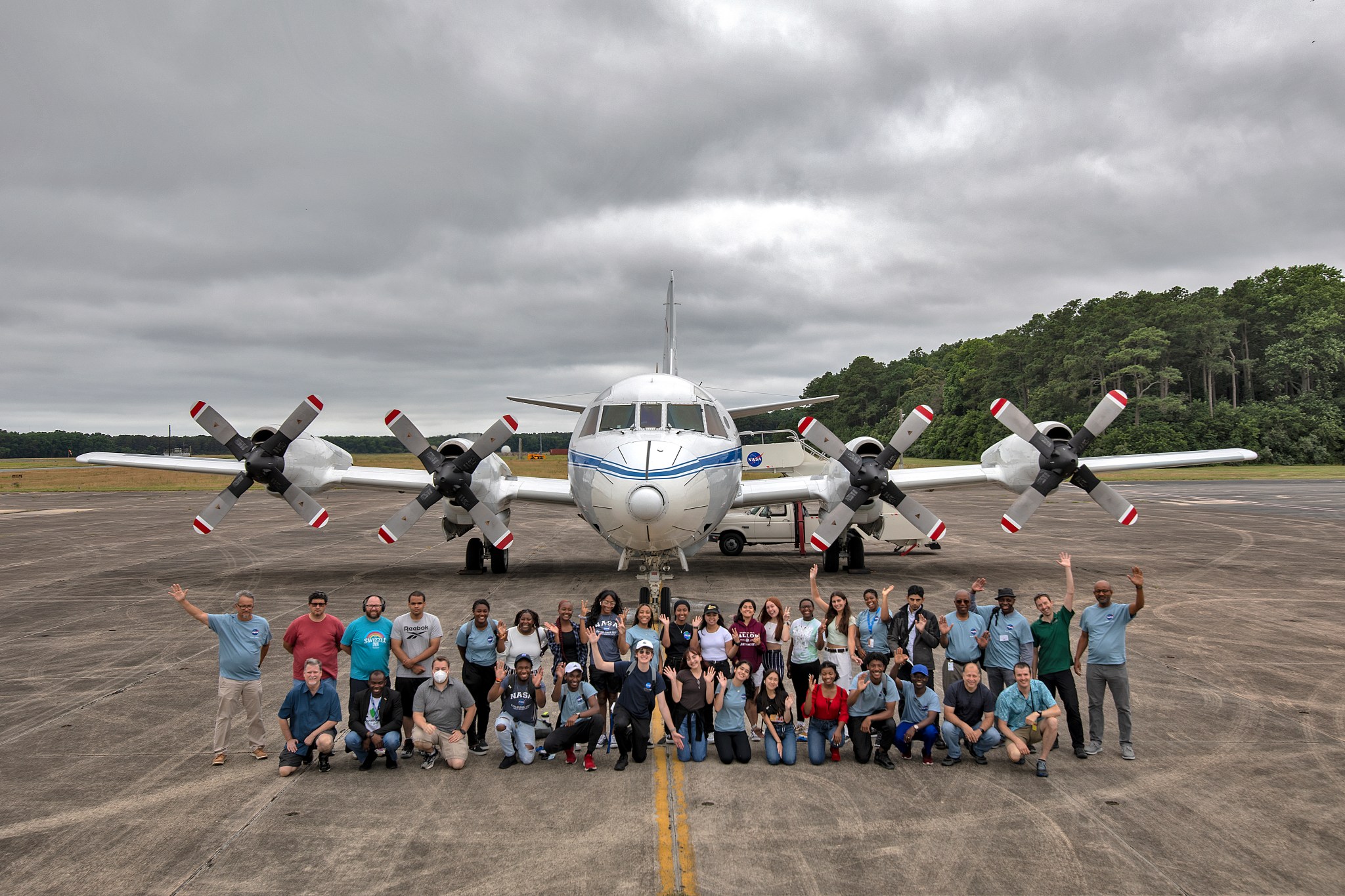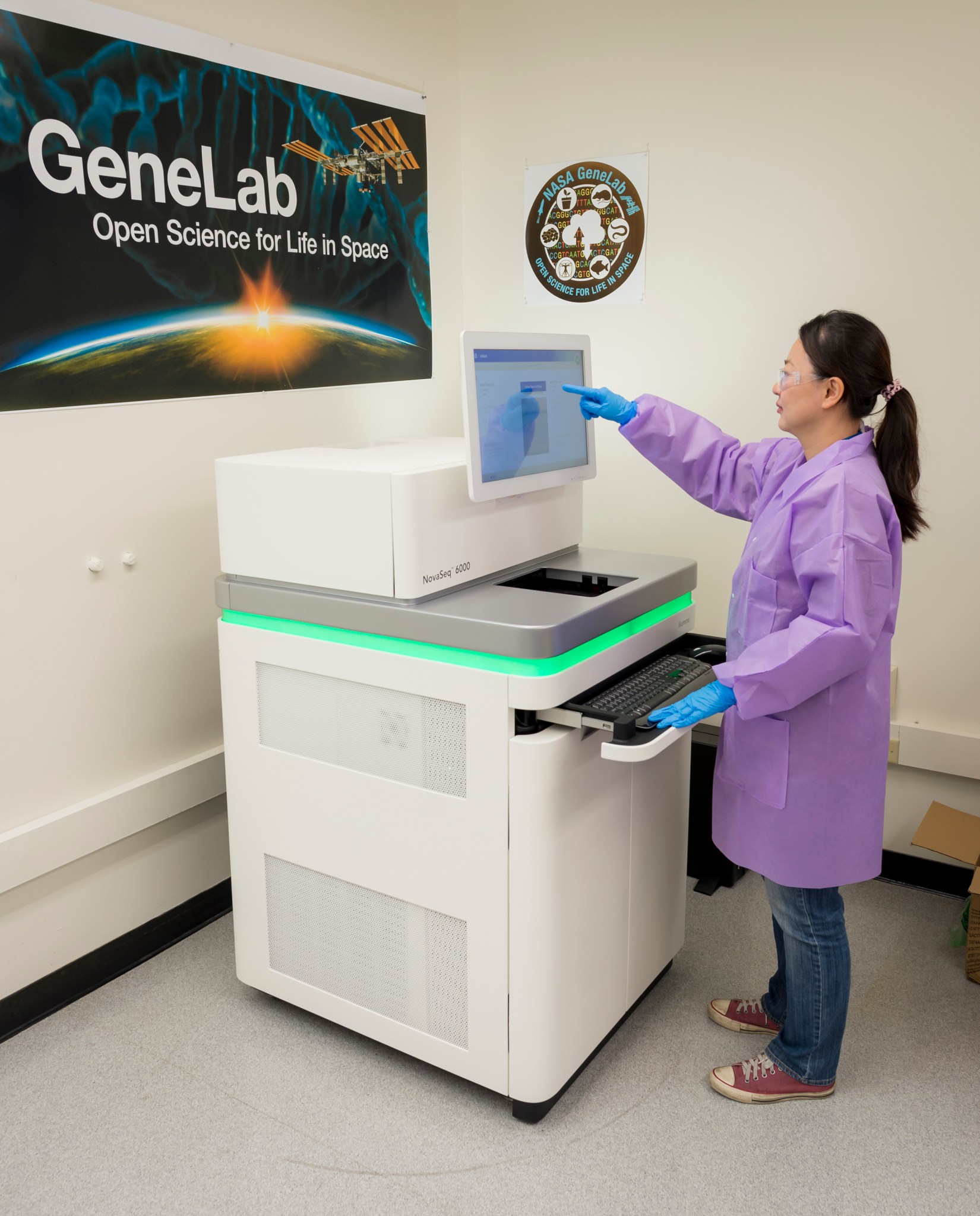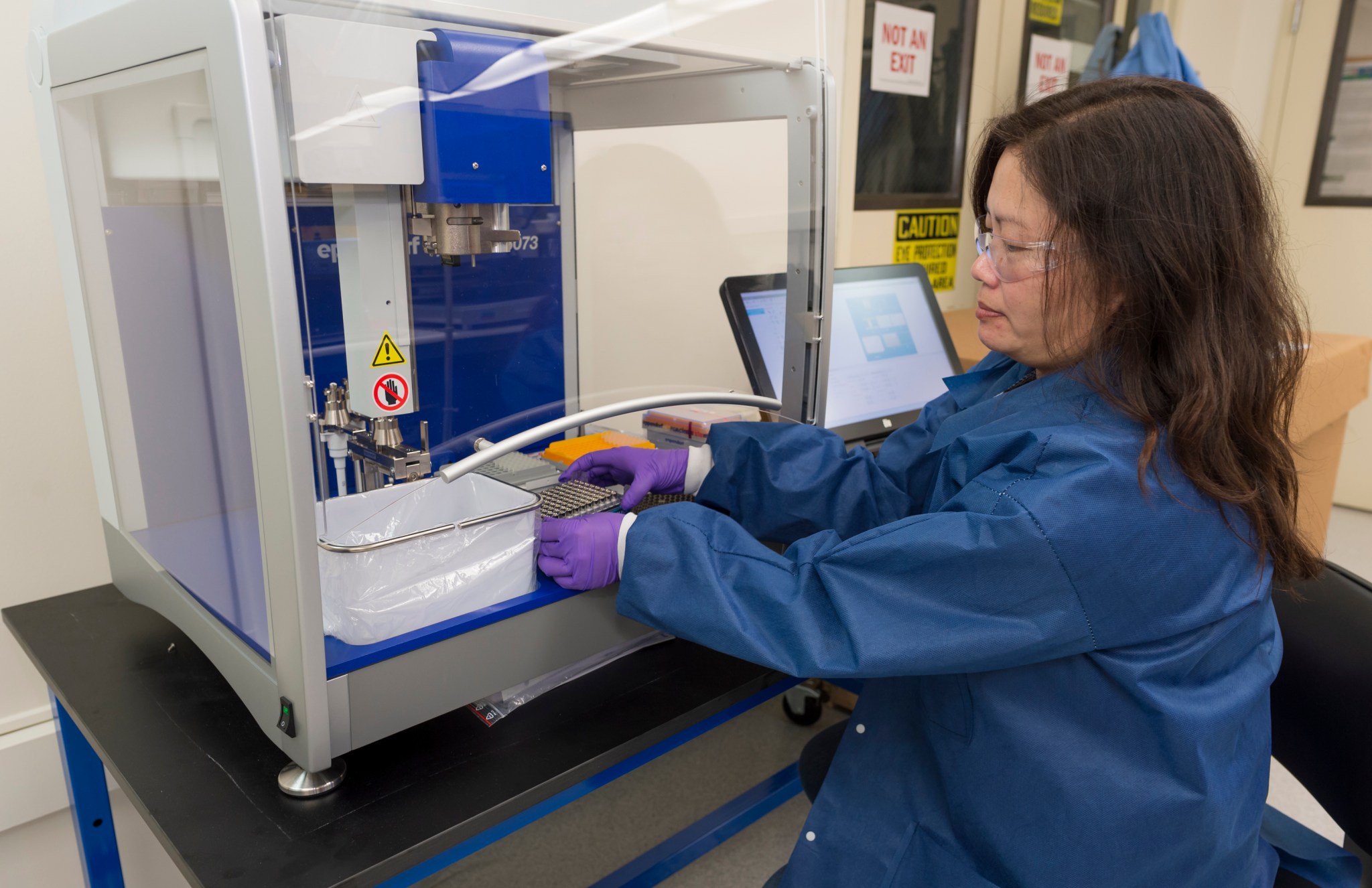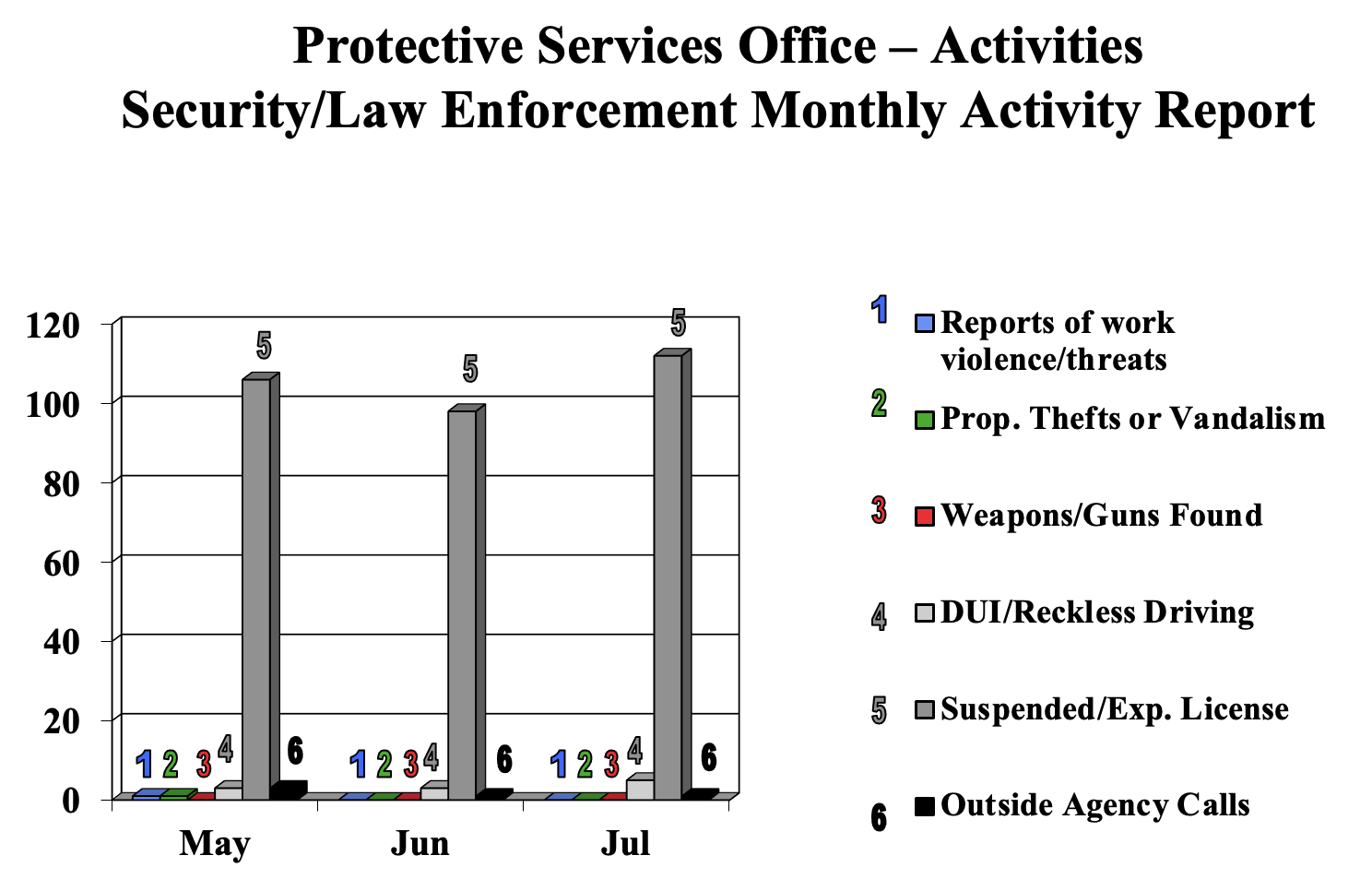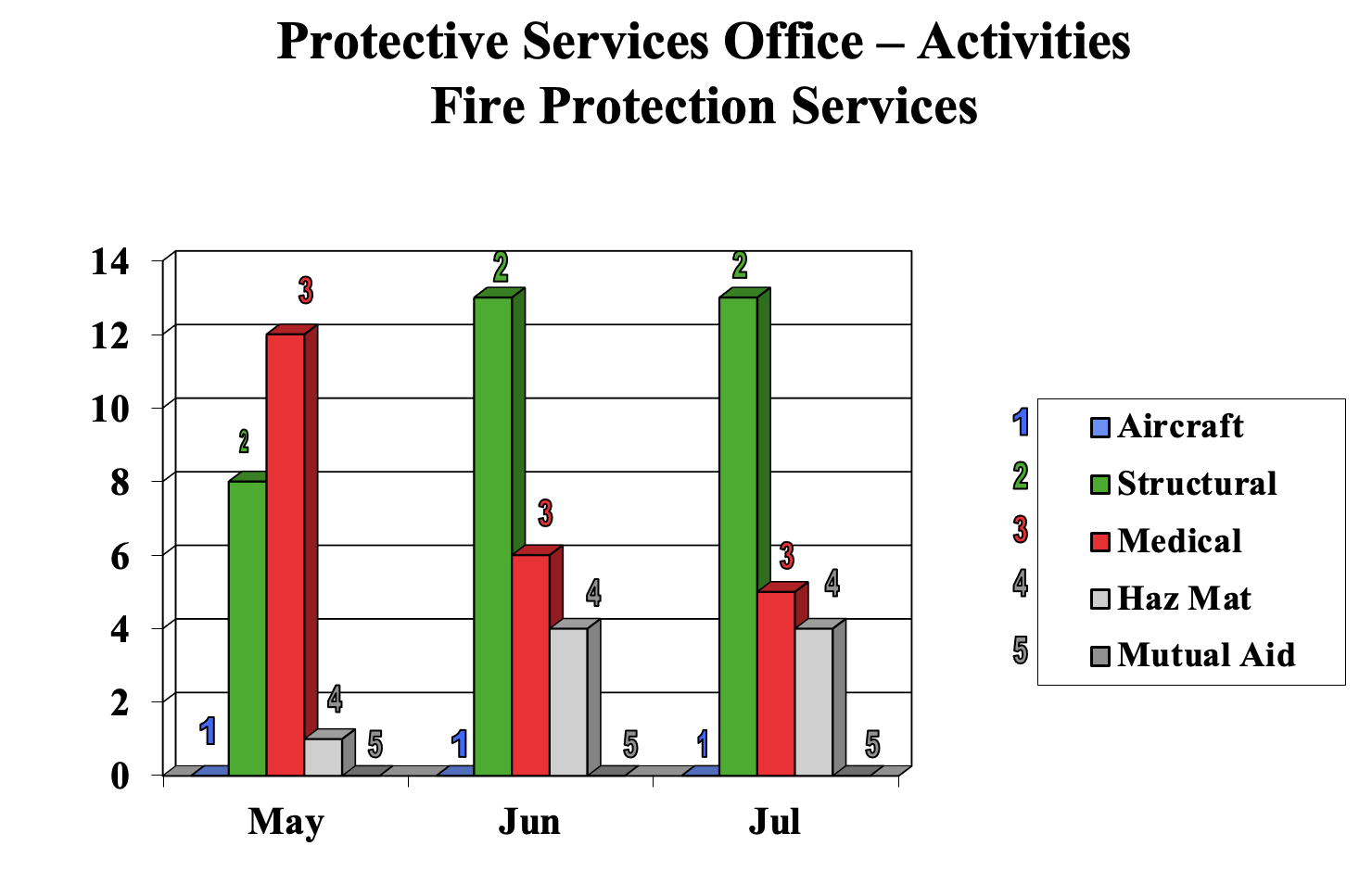Vice President Meets with National Space Council in California
by Abigail Tabor
Vice President Kamala Harris met with the National Space Council Friday, Aug. 12, at the Chabot Space and Science Center in Oakland, California, home to the official visitor center for NASA’s Ames Research Center in Silicon Valley. Harris discussed upcoming priorities for national activities in space, including strengthening public-private partnerships and the benefits of space exploration for all.
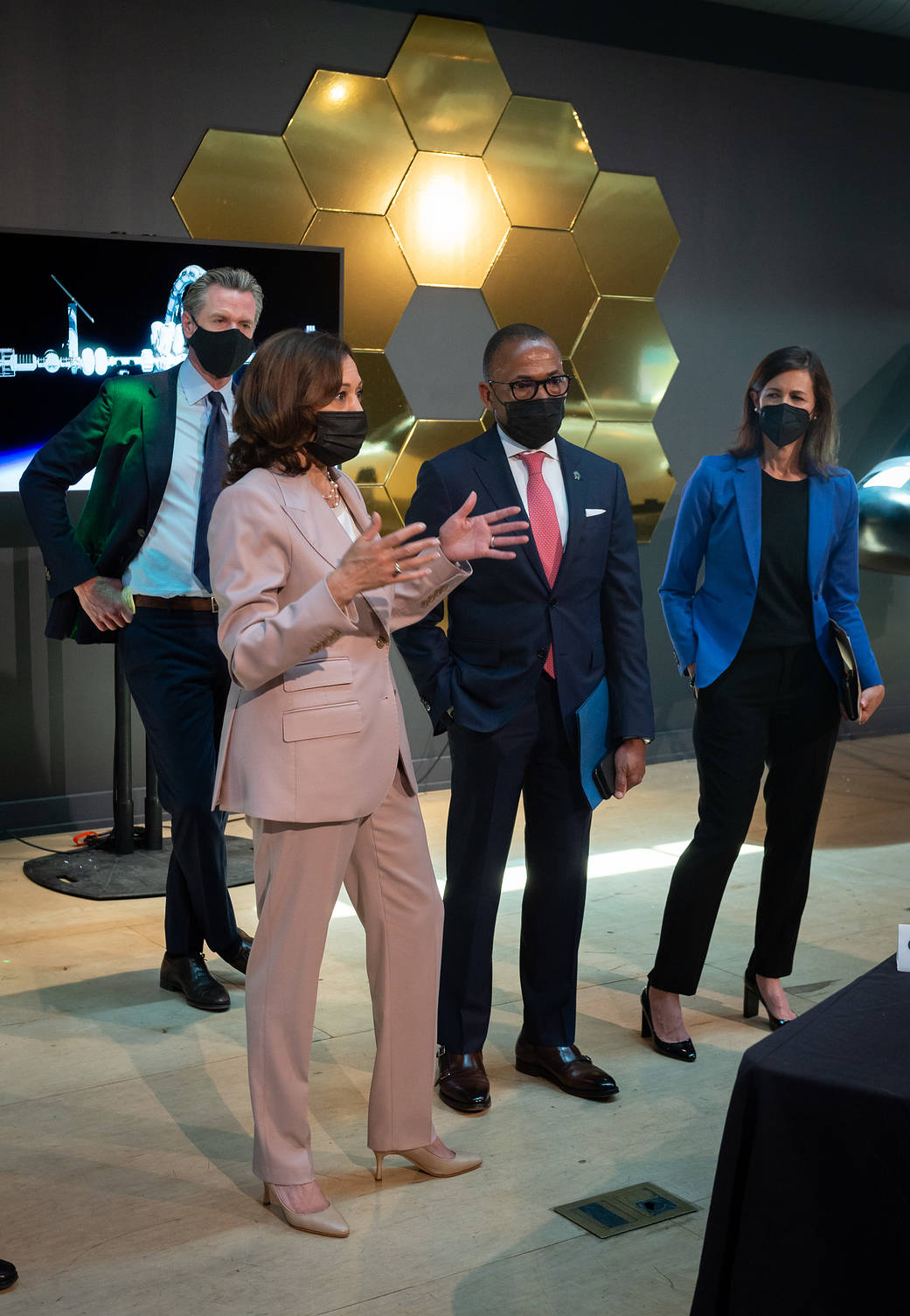
In her speech, the vice president – who also serves as the chair of the National Space Council – discussed the continued importance of partnerships for future endeavors and innovation in space, including NASA’s Artemis missions at the Moon. Aerospace companies at the event had the opportunity to share their work with the vice president at a series of booths.
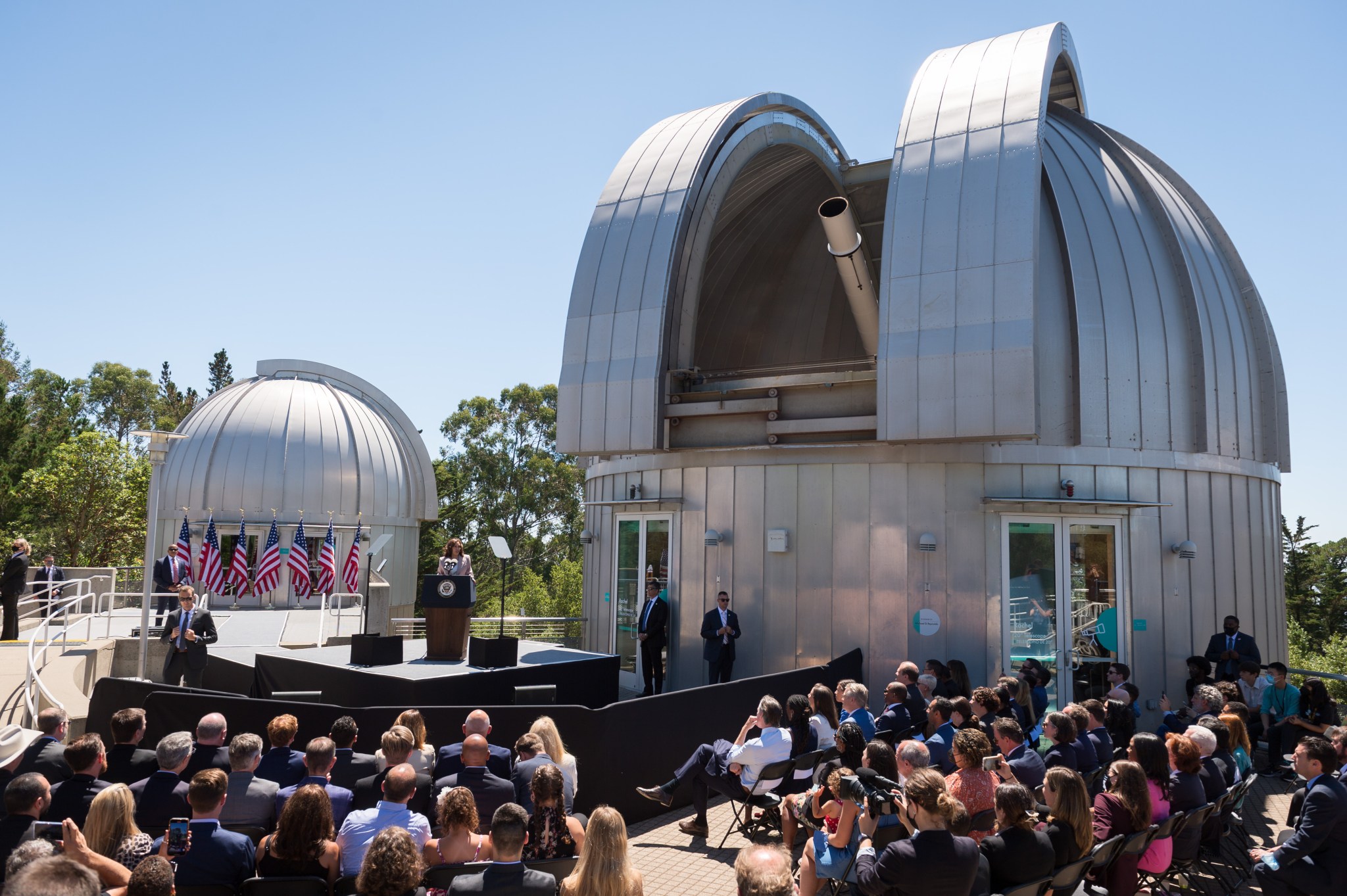
NASA Ames Center Director Eugene Tu, Ames Earth Science Division Chief Florian Schwandner, Governor of California Gavin Newsom, Mayor of Oakland Libby Schaff, as well as representatives from nine aerospace companies were in attendance.
Harris also highlighted the importance of space technologies to combat the climate crisis and STEM education to cultivate a creative and diverse workforce capable of meeting the challenges of tomorrow.
“It’s been an honor to be a part of this event in the vice president’s hometown, especially here alongside Ames’ visitor center at Chabot,” said Tu. “Ames is often a focal point of collaborations with private industry, and today has been a wonderful moment to see so many of NASA’s partners come together to discuss an enriching and shared vision for space.”
We Are Artemis: NASA Ames Artemis Experts Prepare for First Launch
by Rachel Hoover
NASA’s journey to the Moon with the launch of Artemis I, an uncrewed flight test of the Space Launch System rocket and Orion spacecraft, is a major milestone on the agency’s path to extending human presence to the Moon and eventually Mars. The flight test is made possible by the working people of the agency, who have spent years on the projects that will make this mission happen.
Meet Rita Eick, Parul Agrawal, Jeremy Vander Kam, and Sergio Santa Maria from NASA’s Ames Research Center in California’s Silicon Valley. They are four of the people whose contributions to the NASA mission will make Artemis I a reality.
What is your role at NASA and in support of Artemis?
Sergio R Santa Maria: I am currently the lead scientist for NASA’s BioSentinel mission, the first long-duration biology experiment beyond low-Earth orbit. My primary role is to ensure that the biology inside BioSentinel is able to survive the trip to deep space and that the instrument is able to provide support to the biology experiment. BioSentinel is a CubeSat, or small satellite, that will ride to space on the Space Launch System rocket and be deployed after the Orion spacecraft is flying on its own toward the Moon.
Parul Agrawal: I am a project manager and the lead for Orion operations at Ames. Our role is to build a series of spacecraft to transport astronauts and cargo to lunar orbit and provide their safe return to Earth, including carrying with them lunar samples they will collect on the Moon’s surface. Our key contributions to Orion include heat shield development, aerothermodynamics, and aerodynamic modeling. My role is to ensure that our team is meeting their milestones and they have sufficient resources and budget to support the project.
Jeremy Vander Kam: I am the deputy system manager for the Orion spacecraft’s thermal protection system (TPS) and am responsible for leading the Ames team that has developed Orion’s heat shield and thermal tiles. I will also go out to sea for Orion’s recovery and perform the first vehicle inspections on the recovery ship.
Rita Eick: I am a test engineer at the NASA Ames Unitary Plan Wind Tunnel. I manage and execute wind tunnel tests for industry, NASA, and other government customers who need to study how their designs for aircraft or spacecraft will behave in flight.
What is your hometown?
Santa Maria: I was born and raised in Lima, Peru, and moved to the United States to pursue my doctoral degree in Texas, then New York, and now in California since 2014.
Agrawal: My childhood was spent in Allahabad, a mid-sized remote town in Northern India. While growing up I faced many challenges because my aspiration to study science, technology, engineering, and math (STEM) subjects did not conform to society’s expectations for a North Indian girl.
Vander Kam: Sunnyvale, California.
Eick: I was born in Baghdad, Iraq, and moved to the United States when I was 8 years old. I grew up in Encinitas, California, a small beach town near San Diego.
What led you to work to support Artemis?
Santa Maria: During my doctoral and postdoctoral studies, I worked with model biological organisms to study how they respond to damaging agents like ultraviolet light or ionizing radiation, similar to the radiation found in space. When I was completing my postdoctoral program in New York City, an opportunity to join the BioSentinel team at Ames Research Center appeared, and I immediately applied. After a few interviews, I got the job and moved to California. I was not fully aware of it at the time, but the fact that this mission is going to deep space made all those years studying worth it!
Agrawal: Since early childhood I have been inspired by the complexity of mother nature and vastness of the universe. After I completed my PhD in aeronautics and astronautics, my goal was to work at NASA so I could be at the forefront of space exploration. I was ecstatic when I was offered a scientist position at Ames to support heat shield analysis for crewed spacecraft. For 10 years, I worked on projects that supported spacecraft heat shield development and entry systems. Orion was the first project I was given the responsibility to manage, due to my technical expertise.
Vander Kam: I started working on the Orion program in 2006, when it began, because it was an opportunity to be a part of an extremely exciting team effort to return humans to the Moon. I was excited about doing something that involved real space hardware.
Eick: At the wind tunnel where I work, the Space Launch System team is one of our customers, and I have supported many tests of the rocket throughout my six-year career at Ames. These are aerodynamic tests using a scale model of SLS that measure how much the rocket vibrates, which parts are most affected, how much pressure it will experience in flight, and more. In general, our wind tunnel testing complements computer simulations of the same aircraft or spacecraft design. When the two agree, a design team knows they can move forward with building the real thing.
What does Artemis mean to you? How does it feel to see Artemis I launching after working on it for so long?
Santa Maria: It will be the end of a very fulfilling journey, having learned a lot about how to fly a mission to deep space and knowing the amount of effort and the many people that took to make this work. We, of course, hope that the mission is successful, but, most importantly, that it paves the way for future biological missions to deep space.
Agrawal: When I first learned about Artemis – a very forward-looking, all-encompassing plan towards human space exploration – it filled me with hope and a sense of purpose. We are fortunate to have a great vision and support for the Artemis program. With the Artemis I launch, we will meet the first major milestone of that vision and demonstrate the dedication, technical knowledge, and passion of the people at NASA.
Vander Kam: Artemis has been my career for a long time at NASA. It’s really a climax to a lot of hard work over many years and I’m really excited to see it fly!
Eick: I have not worked on it as long as many others who have dedicated their time to the mission, but Artemis, to me, means “passion.” All the people who have directly and indirectly supported the mission are passionate about their work and it clearly shows.
What would surprise people the most about your job?
Santa Maria: I would say that a lot of what I have been doing for the last couple of years is more related to engineering and planning than biology. I got to learn a lot from our engineering teams and about how a project works, something I did not have to worry about during my time in academia.
Agrawal: I come from a town in India where even now, after several decades, most girls don’t dream of working at places like NASA and managing flight projects. I hope my story will encourage more children to dream big and have the courage to not let any barrier come in the way of achieving their dreams.
Vander Kam: Folks might be surprised about how much of my job is coordination and communication. I spend a lot of time on the phone with our teammates at Johnson Space Center in Houston, at Kennedy Space Center in Florida, and other places.
Eick: It takes a lot of effort to explain to others what I do, so that, in itself, is a surprise to people. Basically, I help test new aircraft and spacecraft designs by simulating their flight inside a giant wind tunnel. Those that have come to the facility for tours are surprised by the size of it. It’s massive and requires a tremendous amount of support to operate and maintenance to keep it running.
Through Artemis missions, NASA will land the first woman and first person of color on the Moon paving the way for a long-term lunar presence and serving as a steppingstone to send astronauts to Mars. Would you like to share any reflections on that milestone?
Vander Kam: I think this is a great milestone to achieve for humanity. It’s been a long road of discouraging social behavior here on Earth, and I think that this milestone is important to remind us all to aspire to greater unity.
Agrawal: The Artemis program is forward-looking, not only in terms of the technological advancement for deep space exploration but also in the sense that it is all-inclusive and it belongs to everyone. We all could proudly proclaim that we are the Artemis Generation. To me, this is a big leap for Artemis compared to its predecessors.
Eick: It’s about time a woman and/or person of color will have the opportunity to be the face of the mission. It will be one giant leap for humankind.
From tests on the ground long before launch to scientific expertise in space biology, each has had a role in the next step towards NASA’s return to the Moon and future journey to Mars.
Congratulations to Ames Center Director Dr. Eugene Tu for Receiving the Distinguished Leadership in Science and Technology Award
On Saturday, Aug. 6, our center director, Dr. Eugene Tu, was honored at the 2022 Asian American Engineer of the Year Award Ceremony, receiving the Distinguished Leadership in Science and Technology Award. This prestigious award was presented to Eugene to honor his outstanding leadership of the Ames workforce, who provide critical research and development support that make NASA’s aeronautics and space missions possible.
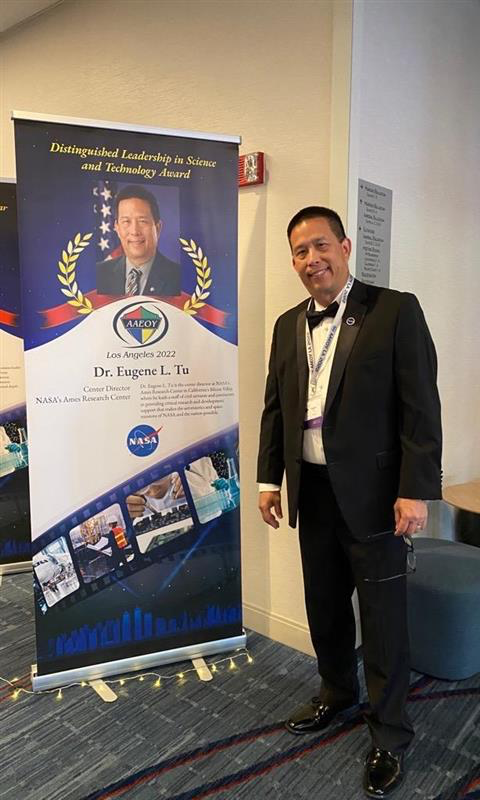
The Asian American Engineer of the Year (AAEOY) is an annual event on a national platform recognizing and honoring outstanding Asian American professionals in science and engineering for their technical achievements, leadership, and public service.
Since 2002, hundreds of Asian-American professionals from leading corporations and research institutions as well as the United States Armed Forces have been selected as recipients of the highly regarded award. Past awardees included Nobel laureates, academics, corporate executives, and astronauts.
Please join me in congratulating, celebrating, and honoring Eugene on this momentous occasion. He has guided our center through the best of times, unprecedented challenges, and seasons of change with humility, care, and exemplary leadership.
We are proud of this award and achievement, and proud to have him as our center director.
Congratulations, Eugene!
What are Ames’ Contributions to Artemis I?
by Frank Tavares
Artemis I marks the start of a new era of space exploration back to the Moon and beyond to Mars – and NASA’s Ames Research Center in California’s Silicon Valley has helped the agency pave the path to achieve liftoff.
This first mission as part of Artemis will be uncrewed, proving the capabilities of the Space Launch System (SLS) and Orion spacecraft while carrying a host of payloads for technology demonstrations and scientific discovery in cislunar space and beyond.
Ames has made contributions across several parts of Artemis. Ames’ unique facilities and deep scientific expertise allow us to do the forward-thinking research and collaboration to make Artemis a reality.
Space Launch System
In this uncrewed mission, the SLS will launch from NASA’s Kennedy Space Center in Florida carrying the Orion spacecraft, which will travel about 40,000 miles beyond the Moon and return to Earth, paving the path for future human explorers to follow. Ames used longstanding and modern techniques to help ensure the SLS will be ready for liftoff.
Breaking free from Earth’s gravity requires high velocities that create fierce winds for a spacecraft leaving the planet, and any rocket preparing to make the journey must be tested in these conditions prior to launch. This environment has been replicated at Ames from the dawn of the space age using wind tunnels – large tunnels with air inside to replicate objects moving in flight. Ames is home to the largest wind tunnel in the world, and a host of other testing facilities.
For the SLS, the Unitary Plan Wind Tunnel, 11 by 11 feet in size, was used alongside novel testing technologies like pressure sensitive paint. This unique paint allows engineers to see the distribution of pressure on a spacecraft created by the high winds of liftoff in ways that were not previously possible.
Several different Ames teams also supported testing for the SLS, including the Mission and Fault Management, Engineering Risk Assessment, and Computational Fluid Dynamics teams. Ames’ state of the art supercomputing facilities also enabled aerodynamics to be modelled digitally, allowing simulations of the SLS’s launch to discover any potential problems long before countdown, while saving on time, resources, and taxpayer dollars by going digital.
The Human-Computer Interaction (HCI) group at Ames has also leveraged a decade of work developing digital tools for mission operations to support Artemis. These integrated data systems ensure essential information can be quickly accessed at critical moments during a launch, and several of these systems will be used when the SLS rocket launches Artemis I.
Orion Crew Module
The Orion crew module’s descent back home requires a trip through Earth’s atmosphere, where temperatures can rise to levels half as hot as the surface of the Sun. Ames’ Arc Jet Complex can simulate this environment and is where the heat shield that protects the crew module was tested.
To withstand those extreme temperatures, the heat shield’s external layer is composed of a material called Avcoat. During descent, the Avcoat ablates, or burns off in a controlled fashion, transporting heat away from Orion. The material has been extensively tested at Ames’ Arc Jet Complex in preparation for Artemis I.
To monitor Orion’s thermal protection system, engineers and technicians at Ames worked with other NASA centers to design, develop, and fabricate flight instrumentation sensors for the heat shield and backshell of the capsule.
Researchers also used simulation models to predict the launch and entry environments for the capsule. Simulations were also used to provide critical support testing of Orion’s launch abort system, mounted on top of the crew module, for use in an emergency evacuation. Scaled models of Orion were also tested at the wind tunnels at Ames to understand the launch environment and its impact on the capsule.
Ames’ System Safety and Mission Assurance Division has worked to provide quality assurance for the work done on Orion both by NASA and its suppliers and partners. They have also provided workmanship support for heat shield development throughout Artemis.
Bringing Science to the Moon
Along with the Orion crew module, SLS will carry ten small satellites, called CubeSats, many carrying experiments and projects supported by Ames.
The BioSentinel mission will take terrestrial life further than it’s ever gone before – bringing samples of yeast into deep space to study the impact of space radiation. BioSentinel will be the first CubeSat to test biology in deep space.
The solar array used to power the CubeSat was built by the small business MMA Design, LLC, using funding from Ames’ Small Business Innovation Research and Small Business Technology Transfer programs. Mission operations will be conducted in the Multi Mission Operations Center at Ames. Ames’ System Safety and Mission Assurance Division has supported the BioSentinel project providing mission, quality, and software assurance as well as system safety. Once BioSentinel is in operation, they will provide mission operations assurance as well.
The LunaH-Map mission will take a CubeSat to the Moon’s orbit to map the hydrogen enrichments within the permanently shadowed regions of the lunar South Pole. Hydrogen is an important element to map because it could be used to fuel future landers and rockets. This planetary mission will map concentrations of hydrogen on the Moon with a resolution two-times better than previous missions. It’s a new type of planetary mission, using a new type of compact neutron spectrometer to look for hydrogen flying on a fully functional interplanetary spacecraft about the size of a shoebox. The spacecraft will use a low-altitude, elliptical orbit that at times will bring it about six miles above the lunar surface.
NASA has awarded three teams the opportunity to launch their small satellite projects, carrying propulsion, navigation, and communication experiments, on Artemis I through the CubeQuest challenge, managed by Ames.
Looking forward, Artemis III will carry human explorers to the Moon’s South Pole. To prepare for this historic return, Ames’ VIPER rover will travel to that region beforehand in 2024 through NASA’s CLPS program aboard the Astrobotic lunar lander, mapping out the region and learning more about the lunar resources there.
Through Artemis missions, NASA will land the first woman and the first person of color on the Moon, paving the way for a long-term lunar presence and serving as a steppingstone to send astronauts to Mars.
NASA Chief of Staff and Deputy Associate Administrator for Business Operations Visit Ames
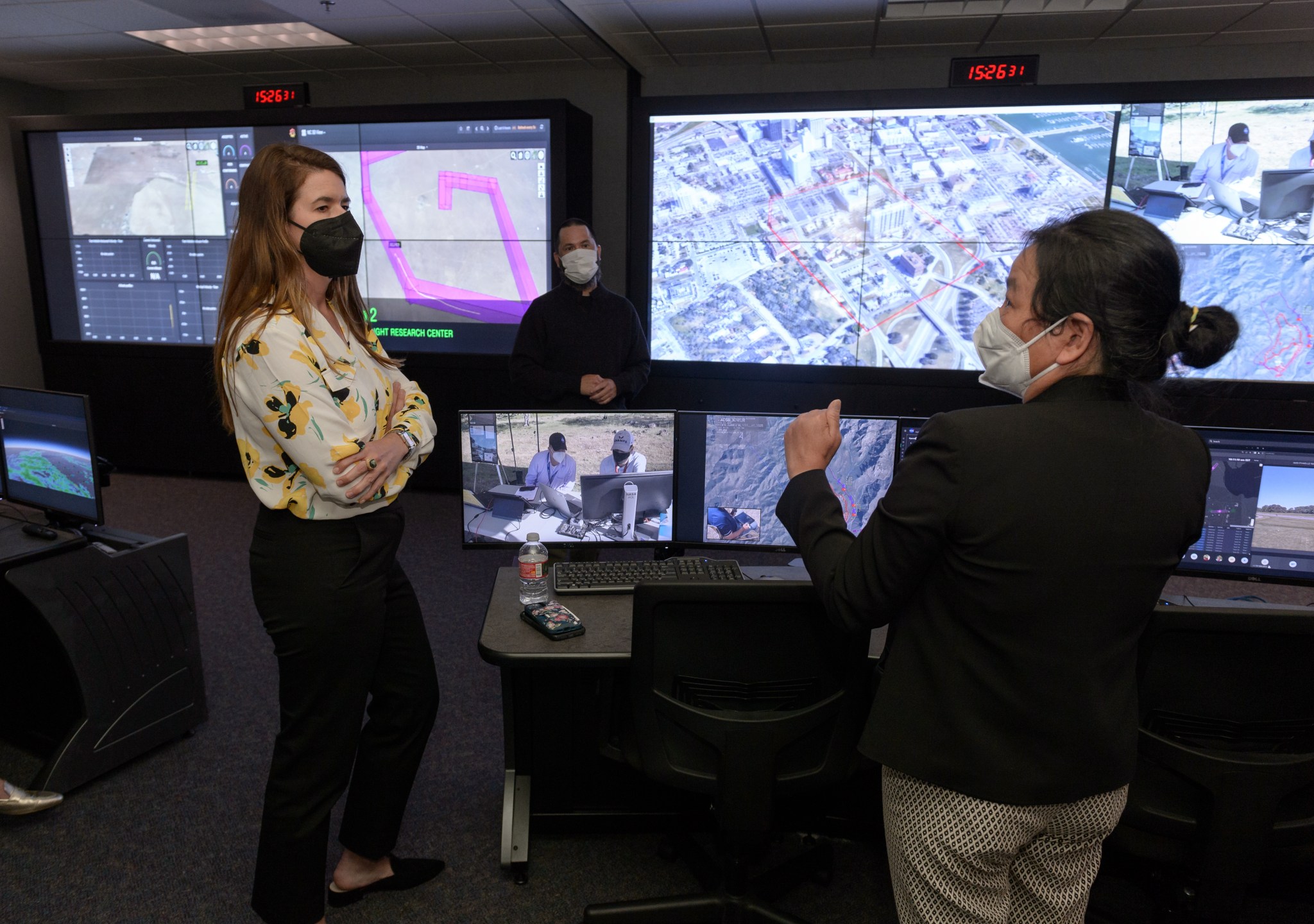
Doing More with Less: NASA’s Most Powerful Supercomputer
by Gianine Figliozzi
With summer in full swing in the Northern hemisphere, many of us are experiencing higher temperatures – in some cases, record breaking heat. The demand for cooling, correspondingly, also is on the rise. Typically, more cooling translates to higher use of resources, such as water and electricity. But the latest expansion in May 2022 to NASA’s innovative, modular supercomputing facility increased the agency’s computational power by 22%, making it NASA’s most powerful, yet energy-efficient, supercomputer.
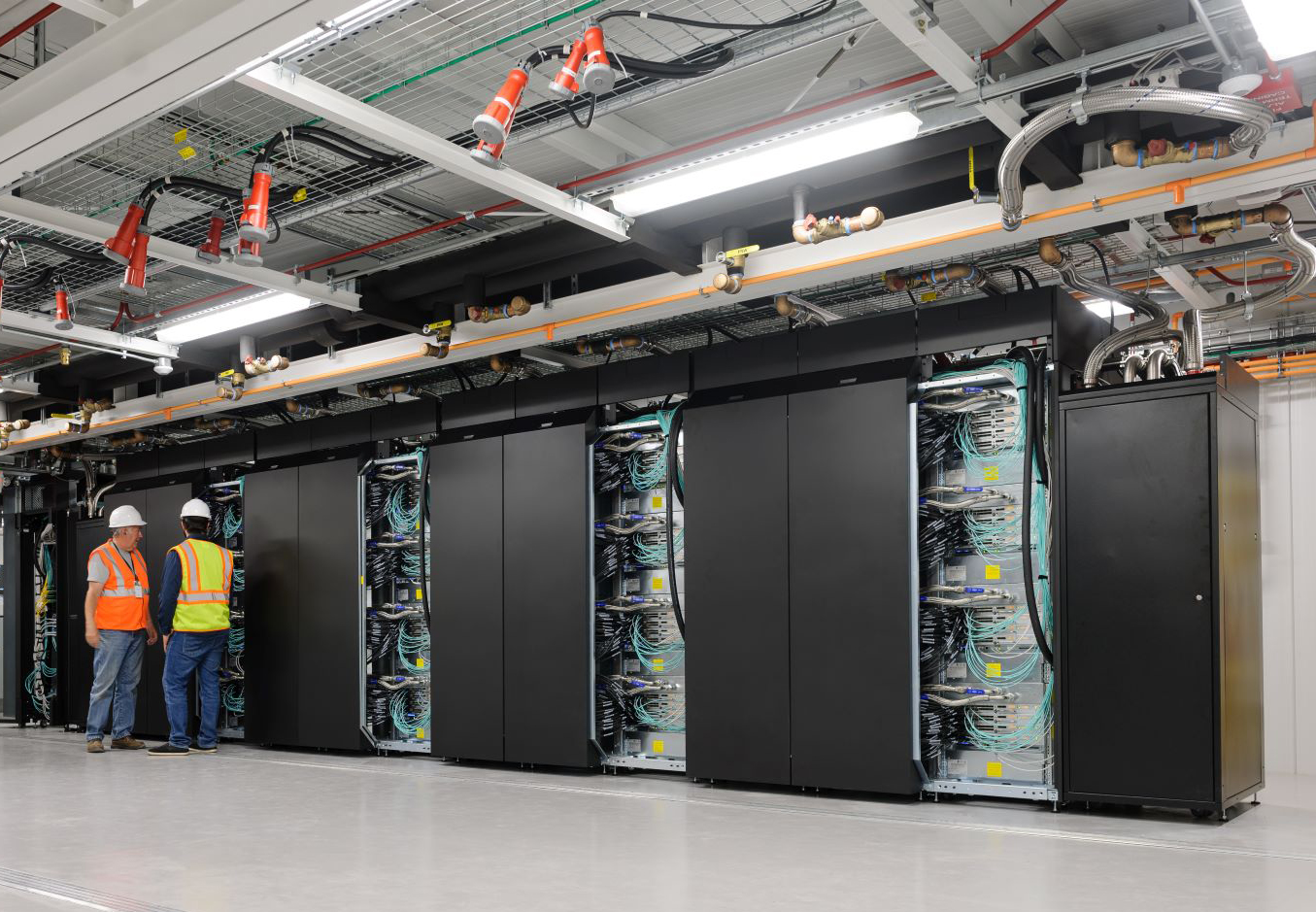
Number-crunching supercomputers are notorious for pumping out a lot of heat, but NASA’s newest supercomputers keep their cool year-round thanks to the design of a facility that debuted in 2019 and cleverly uses the local climate to cool high-powered computers naturally.
“NASA uses supercomputers to solve some of the nation’s most challenging problems – from understanding the universe to designing launch systems that will take us to the Moon and Mars as part of the Artemis missions,” said William Thigpen, assistant division chief of High-Performance Computing (HPC) Operations – NASA Advanced Supercomputing Division, and project manager for NASA’s High-End Computing Capability Project at NASA’s Ames Research Center in California’s Silicon Valley.
The Modular Supercomputing Facility (MSF) at Ames uses self-contained modules to house its Aitken and Electrasupercomputers. Think “tiny homes” for big computers. People who participate in the tiny house movement choose small living spaces with low energy demands to save money and use fewer resources. The goals are much the same here.
NASA is committed to reducing the environmental impact of its labs and facilities. The MSF’s design and cooling technology is so efficient that, with the same amount of electricity used for cooling, it can cool seven times the amount of computing power as our traditional supercomputing facilities. Each module saves millions of gallons of water and taxpayer dollars per year, making the MSF one of the most energy-efficient data centers in the world.
The modules take advantage of Silicon Valley’s mild, dry climate to naturally cool high-powered computers. By using a combination of outdoor air, fan technology, evaporative coolers, and a circulating water system, they remove the heat generated by the computers.
This modular approach makes it easy to upgrade the facility with the latest technologies for fast-turnaround work on high-priority NASA missions. For example, an expansion in 2020 nearly tripled the system’s original computational power. Engineers can build entirely new systems in months, rather than years. That means NASA missions that rely on these computers can keep moving forward with fewer disruptions.
High-end computing plays a big role in supporting the agency’s engineering and science work. This includes a wide variety of projects that require enormous amounts of computing power such as space exploration, aeronautics, and Earth science, as well as the design and testing of capabilities needed to send humans to the Moon with the Artemis missions.
“By taking care to deploy our supercomputing systems with a focus on drastically reducing the power and water necessary to cool them, we minimize the impact we have on our environment,” said Thigpen.
Collaborators:
It takes a village to develop the infrastructure for NASA’s modular supercomputing sites. Collaborators to design, build, and operate the one-acre MSF site included industry partners Hewlett Packard Enterprise (HPE), Intel, and Mellanox, along with facilities specialists Schneider Electric, Jacobs Engineering Group, Inc., AECOM, and Tri-Technic, Inc.; and is managed under contracts with ASRC Federal and CSRA, Inc.
U.S. Navy Rear Admiral Anne Swap Visits Ames Research Facilities
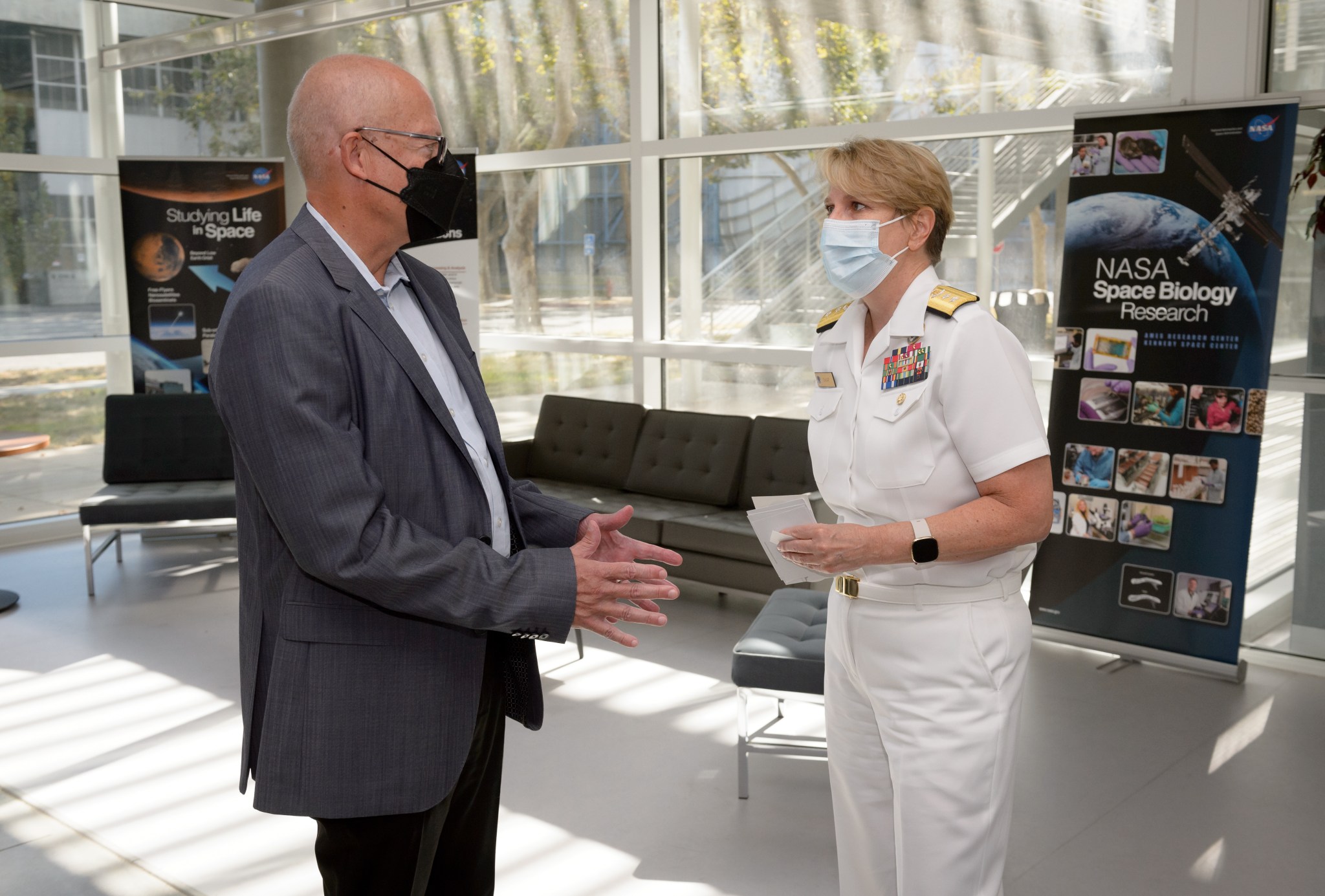
Opened in 2020, the Biosciences Collaborative Facility brings space biology, astrobiology, and bioengineering researchers together to advance NASA’s strategic goals in both human exploration and science. The work conducted in this facility will help spur advances that minimize risks in human deep space exploration, informing the design of future NASA missions and our search for microbial life in our solar system.
Ames has a longstanding history of collaboration with the Navy, including current technology partnerships involving human health, life support and habitation, and flight vehicle systems.
During the visit, Swap learned about NASA’s GeneLab – an open repository for space biology data anyone can use to make discoveries about ways life from Earth is affected by the conditions of space. Biological space research helps find solutions for astronaut health and promotes the well-being of humans here on Earth. Additionally, Swap learned about the Lunar Explorer Instrument for Space Biology Applications science suite, an instrument that will conduct biological research on the surface of the Moon. This investigation will study how the combined effects of partial gravity and deep space radiation influence biological processes.
Swap also toured Ames’ Arc Jet Complex. This facility provides ground-based hyperthermal environments in support of the nation’s research and development activities in thermal protection materials, vehicle structures, aerothermodynamics, and hypersonic entry. The facility tested the heat shield material that will protect the Orion crew module during its reentry after the Artemis I launch, currently targeted for no earlier than Aug. 29 at 5:33 a.m. PDT.
ODEO Associate Administrator Holds Inclusion and Unity Training Exercise at Ames
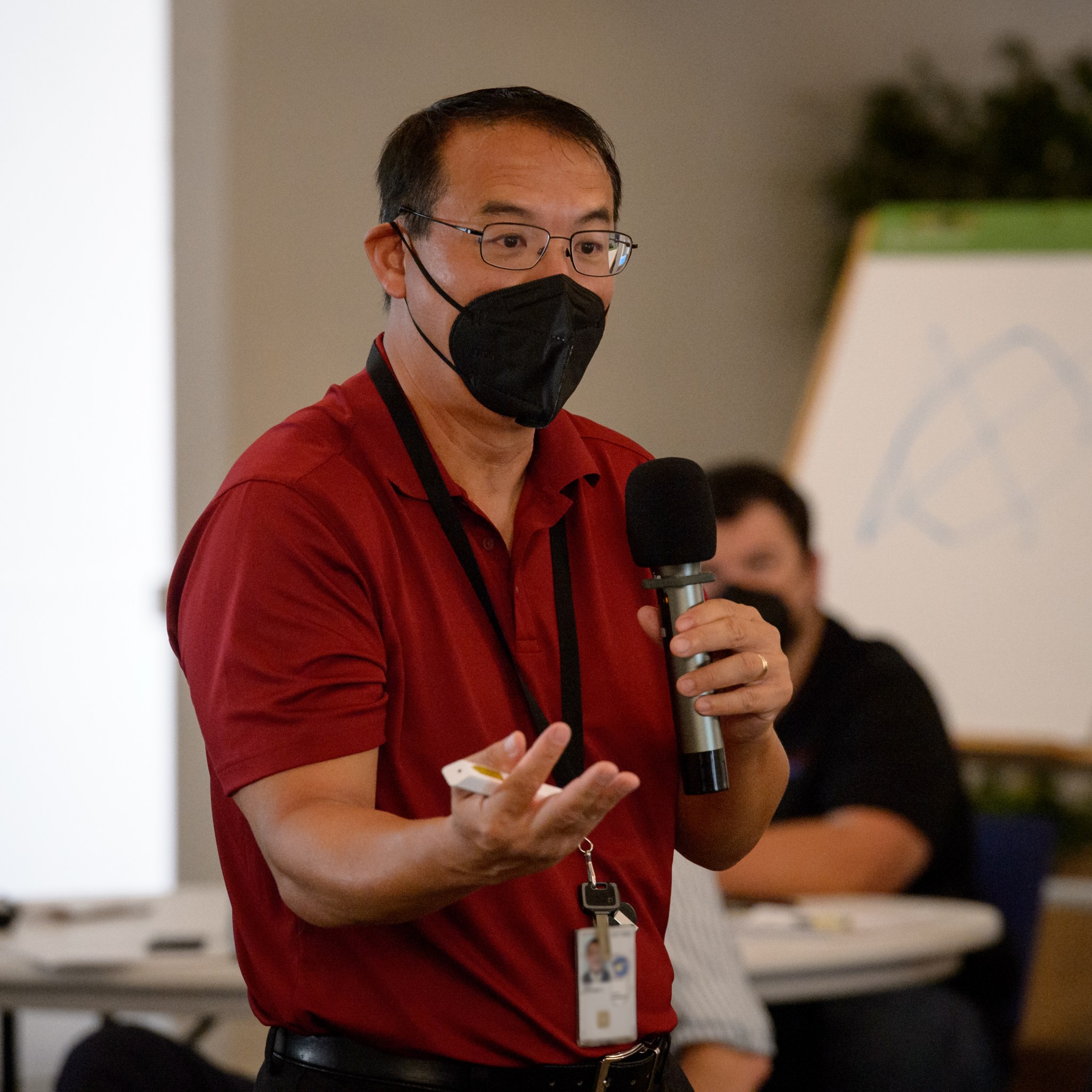
NASA’s B377SGT Super Guppy Turbine Cargo Airplane lands at Moffett Field at NASA Ames
In this picture from 2016, our Super Guppy, a specialized aircraft with a unique hinged nose, lands at Moffett Field at NASA Ames. Boasting an immense cargo area that is 25 feet in diameter and 111 feet long, the Super Guppy can carry items that are virtually impossible to fit inside other cargo aircraft.
In early August 2022, it arrived at Marshall with a structural test article of part of NASA’s mega Moon rocket. The hardware was used in test campaigns at Marshall and NASA’s Kennedy Space Center in Florida and was returned to Marshall for storage.
Ames Experts Participate in Panels at OSHKOSH, the World’s Largest Airshow and Fly-In
Each summer, more than half a million aviation enthusiasts and experts from around the planet descend into a regional airport near Oshkosh, Wisconsin to attend the world’s largest airshow and fly-in, the 2022 Experimental Aircraft Association (EAA), EAA AirVenture Oshkosh (or “Oshkosh” for short). This year, opportunities to engage with NASA at the event were more plentiful than ever, as in-person activities that took place were in Air Traffic Management eXploration, Sky for All, Data & Reasoning Fabric.
The event also included ways to connect with experts and the projects from NASA’s Ames Research Center. From Ames, Parimal Kopardekar (top left photo) presented at the EAA AirVenture Forum, “Future Airspace Operations and Digital Flight Rules. NASA is exploring a proposed new operating mode called digital flight, a complement to Visual Flight Rules (VFR) and Instrument Flight Rules (IFR). Under digital flight rules, the aircraft operator would use automation, traffic awareness, information services, and cooperative practices to ensure separation from other flights in VMC and IMC. The presentation describes how digital flight safely increases airspace access and operating flexibility for qualified operators, and its harmonizing approach to emerging future operations.
Don Durston presented, “NASA Supersonices Research – Leading Toward Quiet Supersonic Fight.” The presentation reviewed NASA’s research on supersonic flight, our wind tunnel and computational fluid dynamic (CFD) studies, and details about the X-59 mission and flight test plans. The goal of X-59 flights is to provide data to FAA to allow civilian supersonic over land as long as boom is quiet enough. Durston also presented “Wind Tunnel Testing for Quesst X-59.” The first flight of the groundbreaking quiet supersonic NASA/Lockheed X-59 is nearly upon us, but how did we get here? The team at NASA has supported research into quiet supersonic aircraft for several decades. Multiple facilities at three NASA centers have supported tests focusing on vehicle aerodynamics and propulsion, flight test probe calibration, and sonic boom research. This presentation will cover the ups, downs, challenges, and successes of the test team as they contributed to the X-59 program!
Huy Tran presented “Women at NASA,” as one of the speakers in NASA aeronuatical careers. Tran and the other speakers in this forum discussed the Aeronautics Research Mission Directorate (ARMD) portfolio, NASA Center roles and collaboration, and share their personal stories describing their path to leadership.
Shivanjli Sharma spoke as a speaker in “Envisioning the Future Airspace with NASA’s Advanced Air Mobility Mission,” highlighting the AAM mission critical commitment, NASA research and development, the National Campaign series, and the AAM ecosystem working groups.
Toward Greater Diversity in Earth Sciences: NASA’s Student Airborne Science Activation Program
by Abigail Tabor
Understanding Earth and the complex influences on our planet’s climate are some of the biggest challenges of our times, and we need all the help we can get to tackle them. But, in the last 40 years, the minority representation in geosciences – meaning Earth, atmosphere, and ocean sciences – has remained relatively low despite its increase in proportion of the U.S. population. This summer, in an effort to address that, a new NASA program welcomed its first class of students.
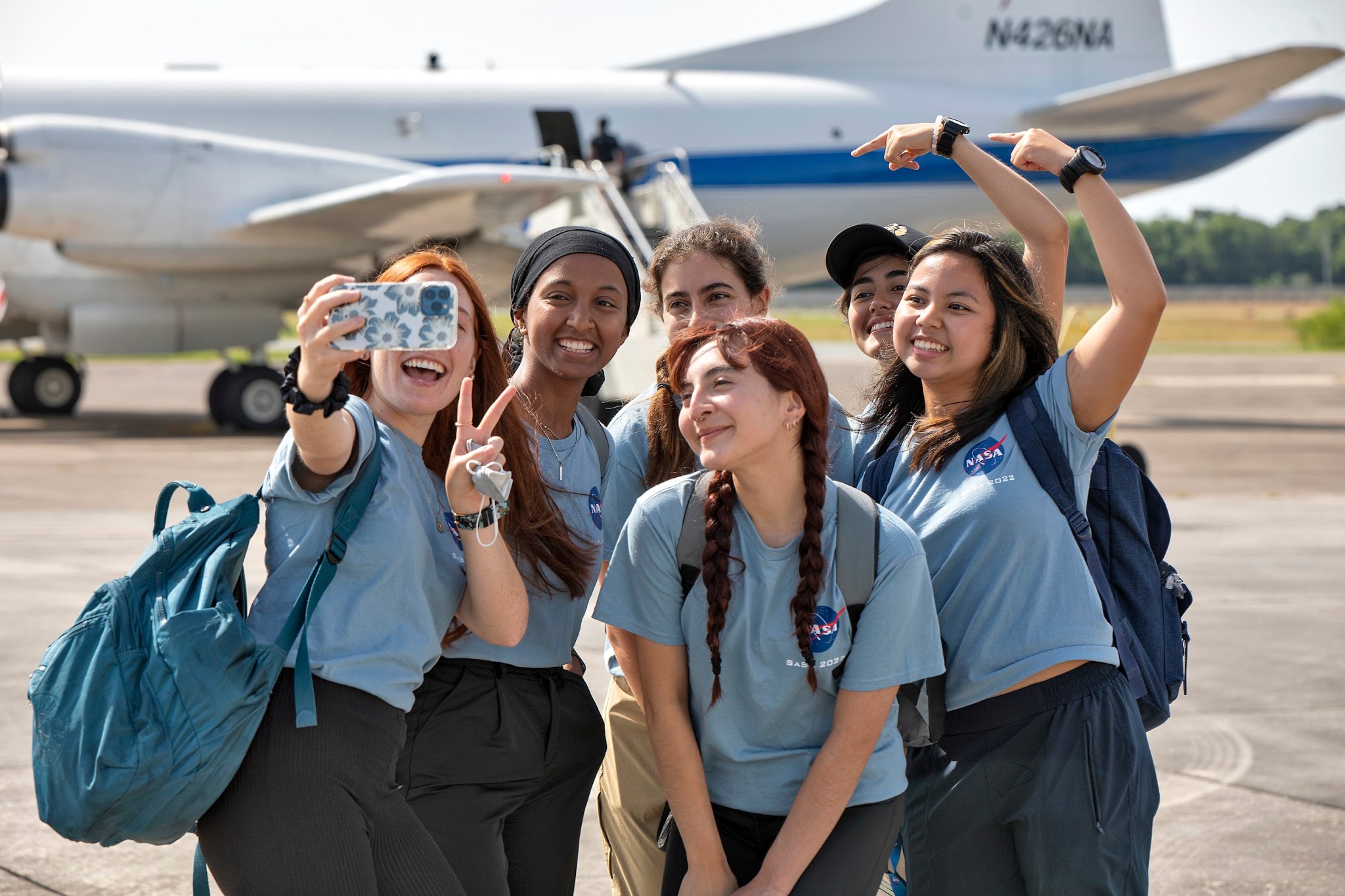
The Student Airborne Science Activation (SaSa) program hosted 25 undergraduate students for an eight-week summer research opportunity. They gained hands-on experience in all aspects of a scientific research campaign, including gathering data from ground-based instruments and flying aboard NASA’s P-3 aircraft to collect measurements of land, ocean, and atmospheric phenomena.
SaSa’s students were competitively selected for this full-time, paid internship – which includes a stipend, housing, and travel – from minority-serving institutions (MSIs) across the country.
“I see the SaSa program as a catalyst for change for the next generation of STEM professionals – those in science, technology, engineering, and math,” said Samiah Moustafa, program manager for SaSa. “In addition to providing a valuable research experience, it will serve as a long-term base for alumni of the program to receive continued mentorship and professional development support from the SaSa community throughout their undergraduate and early career.”
Learning to Study Earth – from Space, the Ground, the Air
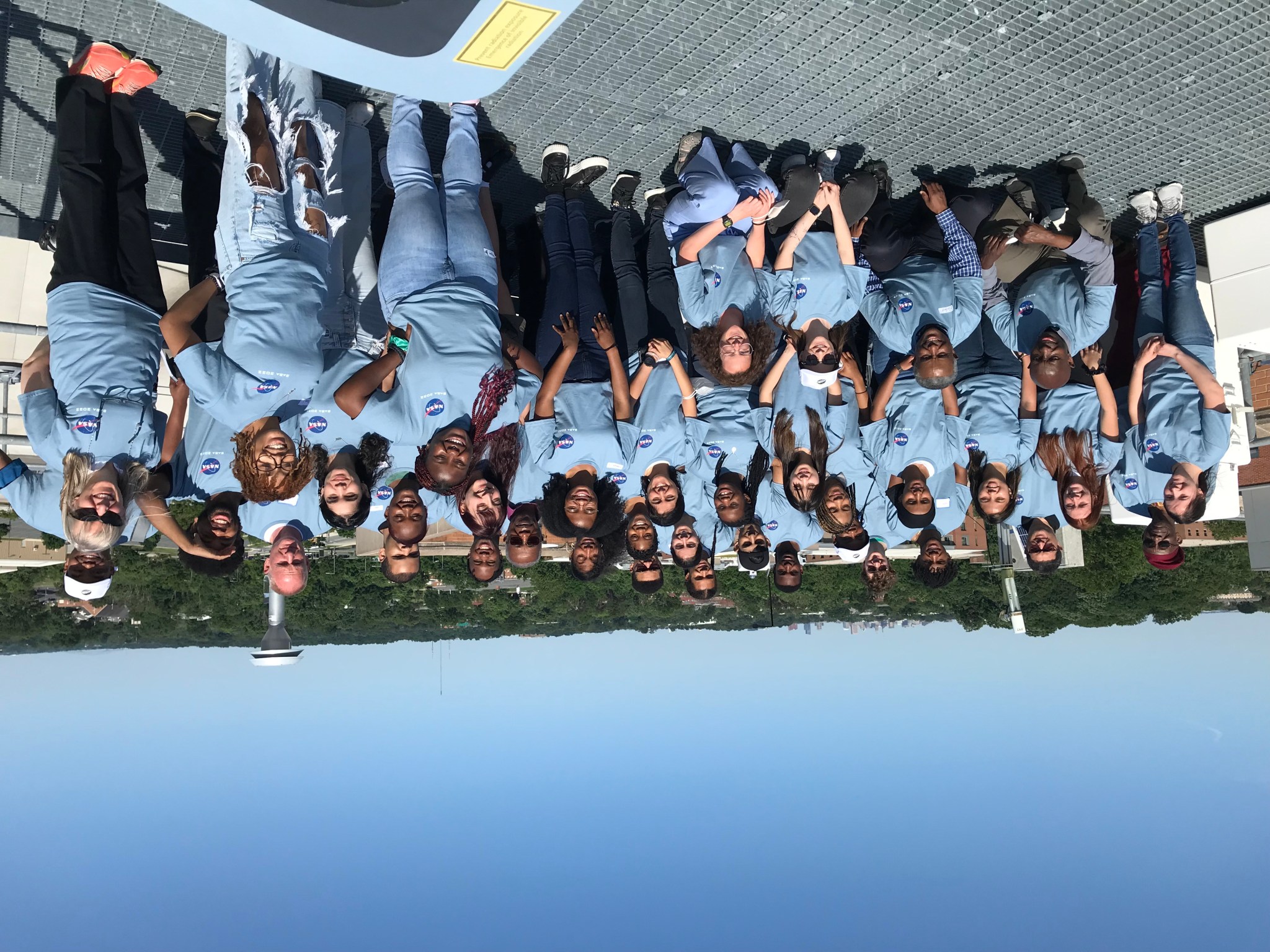
By participating in research activities, SaSa students acquire skills they could one day apply professionally in fields related to energy, resource management, air quality monitoring, and weather prediction. These are all areas that can be influenced by Earth’s atmosphere and climate and where research findings can have significant policy implications.
This summer, in the classroom, SaSa’s participants learned about Earth, atmospheric, and airborne sciences from researchers at NASA and several Historically Black Colleges and Universities (HBCUs) and MSIs in the Washington D.C., Maryland, and Virginia area. These same professionals also welcomed the students into their hands-on research programs.
The young scientists focused on answering questions related to the atmosphere, ocean, and geosciences that contribute to the goals of NASA’s Earth Science Division.
Graduate students on the SaSa team mentored the trainees through the full cycle of a research plan, from developing a feasible research question to identifying and analyzing relevant data sets and formulating the story their results had to tell.
The grad students were integral to the program’s success, and with their guidance SaSa’s participants designed research projects using NASA and related data to address two major themes: How human-caused air pollution has implications for people and the environment, and how large-scale meteorological factors influence local weather conditions.
Their studies relied on measurements taken by satellites, instruments on the ground, and others carried by the P-3 aircraft, one of NASA’s airborne laboratories. The student researchers collected data during flights out of NASA’s Wallops Flight Facility on Wallops Island, Virginia, in early July.
Through the SaSa program, participants learned practical skills for working with science equipment and real data, preparing them to advance their undergraduate studies and potentially enter STEM graduate programs – as well as NASA and other research careers. But science skills are only half the equation. The program also provides the social support important for staying on one’s chosen path.
Paying It Forward
The program’s nickname is an acronym, but it has a double meaning: “sasa” means “now” in Kiswahili – the language also known as Swahili – conveying the urgency of the program’s mission to mentor underrepresented students in the geosciences.
“Our goal is to attract and recruit underrepresented students during their first and second college years, while their perceptions of career opportunities are beginning to form,” said Dr. Charles K. Gatebe, SaSa’s principal investigator and chief of the Atmospheric Science branch at NASA’s Ames Research Center in California’s Silicon Valley. “We want to provide a bridge to influence how and where they choose careers and the means to enter their chosen career.”
Moving from one’s early studies into a career path can be a more difficult transition for some groups of students than others. Black and Hispanic students leave STEM majors at higher rates than white students, and part of the reason may be the lack of diversity around them, research shows. Without many role models, careers in geoscience fields can feel out of reach.
That’s why SaSa aims to bring its participants both skills and support. The students have opportunities to discuss with “near-peer” mentors already on this career path the specific barriers to entering geoscience fields and solutions to overcome them. The program is teaching the ways of field research, while also creating a community of students and positive role models.
Kristina Pistone, a Bay Area Environmental Research Institute scientist based at Ames who provides science support for SaSa, believes the impact of a research internship during college should not be underestimated.
“Part of the reason I, and many others, became a scientist was that I was able to participate in a research program as an undergrad, which allowed me to see science as a viable career path,” said Pistone. “I’m excited to pay it forward to today’s college students.”
SaSa is managed by NASA’s Ames Research Center in California’s Silicon Valley, in partnership with the agency’s Goddard Space Flight Center in Greenbelt, Maryland, Langley Research Center in Hampton, Virginia, and Wallops Flight Facility on Wallops Island, Virginia. Funding is provided by the Science Activation program of NASA’s Science Mission Directorate with additional support from the agency’s Earth Science Division and the Minority University Research and Education Project of NASA’s Office of STEM Engagement.
SaSa’s partner universities are Howard University in Washington D.C., University of Maryland Baltimore County, Coppin State University, and Morgan State University – all three in Baltimore, Maryland – University of Maryland Eastern Shore in Princess Anne, Maryland, and Hampton University in Hampton, Virginia.
More information about SaSa can be found on the program’s website: https://www.nasa.gov/sasa
What is NASA’s GeneLab?
by Abigail Tabor
With GeneLab, NASA’s open repository for space biology data, anyone – from students to specialists – can explore and make discoveries about ways life from Earth is affected by the conditions of space.
Since the first launch of astronauts over 50 years ago, we have discovered that our bodies behave differently in space: sores and cuts heal slower, bones grow thinner, our hearts don’t pump as efficiently, our immune systems weaken.
These changes lead to health risks for astronauts, which must be understood and solved in order to live and work in space for long periods of time. NASA’s GeneLab project is capturing large amounts of space biology data from the human, animal, and plant biology experiments conducted on the International Space Station. Scientists and students can use this priceless data to study how living things are affected by spaceflight and speed up basic science discoveries that can help improve health in space and on Earth.
An Open-Data Treasure Trove
GeneLab’s data is available through an interactive, open-access data system, where users can upload, download, store, search, share, transfer, and analyze certain types of biological
data from spaceflight and Earth-based analogue experiments. The results of many different experiments are housed here, including those conducted previously aboard the space shuttle and, today, on the space station.
These studies have looked at different species (microorganisms, fruit flies, rodents, plants, fish, human cells) and explored the effects of exposure to microgravity, radiation, and other aspects of the space environment. The biological impacts range from changes to the ingredients that make up life (DNA, RNA, proteins…) to effects on the heart, bones, muscles, and other tissues.
To help get a handle on all that, GeneLab houses “omics” data from the space biology experiments. The term refers to huge amounts of information collected about everything biological happening in an organism. The omics data can help scientists answer all kinds of questions – without conducting new experiments – and GeneLab is building tools to help different communities discover the information they contain.
Tools for Multiple Communities
As the project progresses, new ways to interact with GeneLab’s data are being added. A person with a bioinformatics background can download data and get to work immediately analyzing the raw numbers.
Scientists from other specialties benefit from data visualization tools allowing them to skip some initial data processing steps and move quickly toward answering their specific research question. An online workspace lets scientists add their own data to the GeneLab repository and make comparisons with samples from space.
For people curious about space and biology, visualization tools help them boil down complex GeneLab data sufficiently to answer their questions. Students participating in the summer internship program GeneLab for High School have already succeeded, with guidance, at asking new space biology questions and answering them using NASA data from the repository.
Maximizing Knowledge Through Analysis Working Groups
To get the most knowledge possible out of GeneLab’s rare and complex spaceflight datasets, the project has established analysis working groups (AWGs) to investigate specific subsets of the space biology omics data. Each group will find ways of analyzing raw GeneLab data to make it more informative for biologists.
The project is recruiting investigators, bioinformaticians, graduate students, and postdoctoral researchers to participate in the four AWGs, focused on animals (mammals and non-mammals), plants, microbes, and multi-omics strategies.
Biology in Space Benefits Patients on Earth
Biological space research helps find solutions for astronaut health and promotes the well-being of humans here on Earth. Studying what underlies the progression of diseases during spaceflight can provide insight to the onset of similar conditions on Earth. With this greater understanding, we can improve our ability to detect and successfully treat those diseases, too.
Milestones:
- March 2018: The first scientific publication derived entirely from publicly available GeneLab data is published in Scientific Reports.
- November 2020: Several publications using GeneLab data to make new discoveries are included in a large package of space biology research papers, called, “The Biology of Spaceflight,” from Cell Press journals. One revealed that dysfunction in the mitochondria (the powerhouse of the cell) is a key driver in promoting spaceflight-related health risks in astronauts.
- January 2021: GeneLab reaches 300 datasets.
Partners:
The GeneLab project is operated by NASA’s Ames Research Center’s Space Biosciences Research branch. GeneLab is funded by the Biological and Physical Sciences Division within the Science Mission Directorate at NASA Headquarters. The development of GeneLab was also supported by the International Space Station Research Office. GeneLab works closely with the Ames Life Science Data Archive and the Institutional Scientific Collection, both also at Ames, to maximize the value of biological spaceflight experiments by improving access to research data and experimental specimens.
Learn more:
- Mitochondrial Changes Key to Health Problems in Space (NASA story, November 2020)
- Legacy of Space Station Biology Samples Stored in Unique Archive (NASA story, November 2020)
- Marianne Sowa and Jack Miller Discuss Radiation Science Using GeneLab (NASA in Silicon Valley Podcast episode, March 2018)
- Sylvain Costes Talks About NASA’s Treasure Trove of Space Biology Data (NASA in Silicon Valley Podcast episode, November 2017)
Statistical Summary of Activities of the Protective Service Division’s Security/Law Enforcement and Fire Protection Services Units for Period Ending July 2022
















